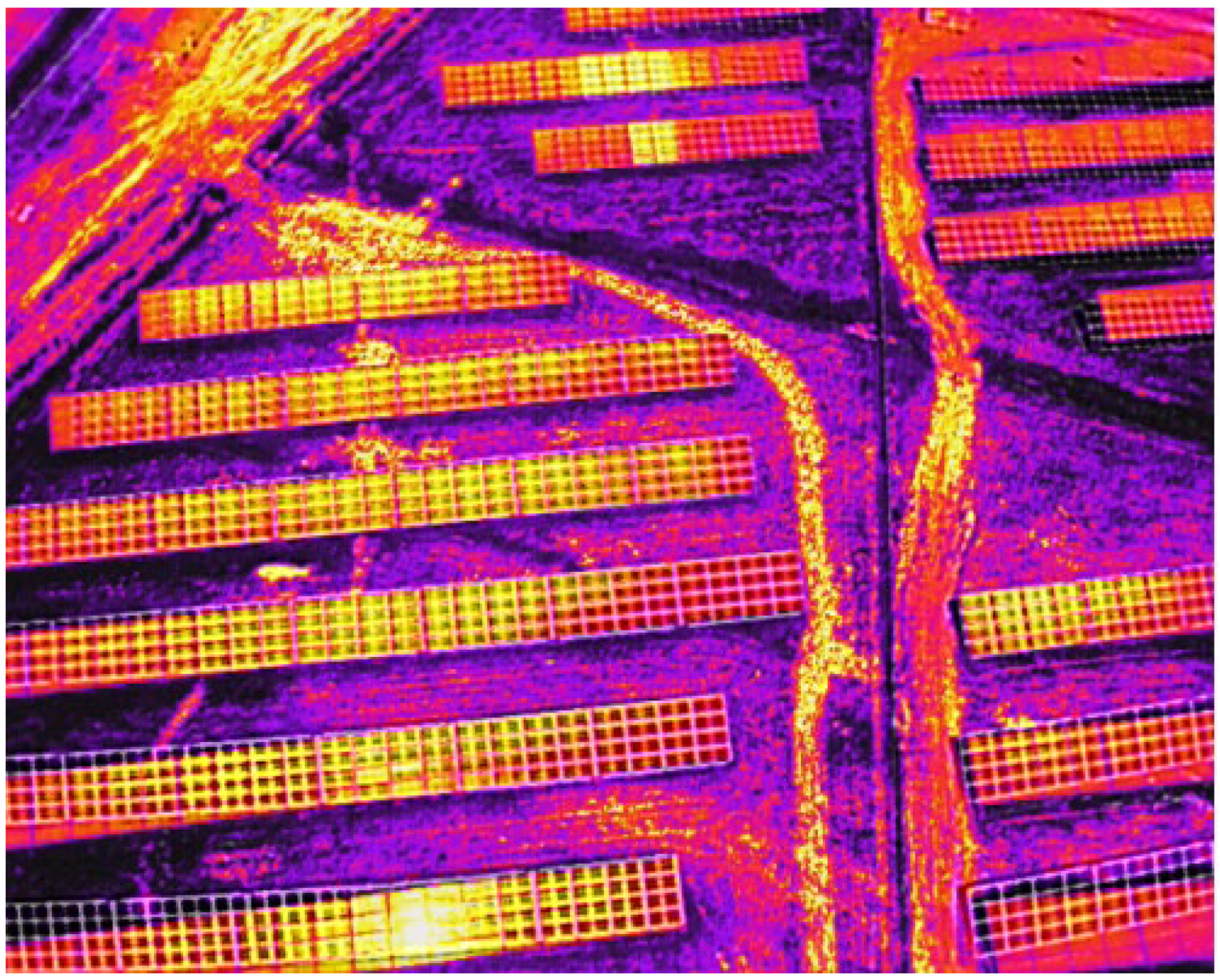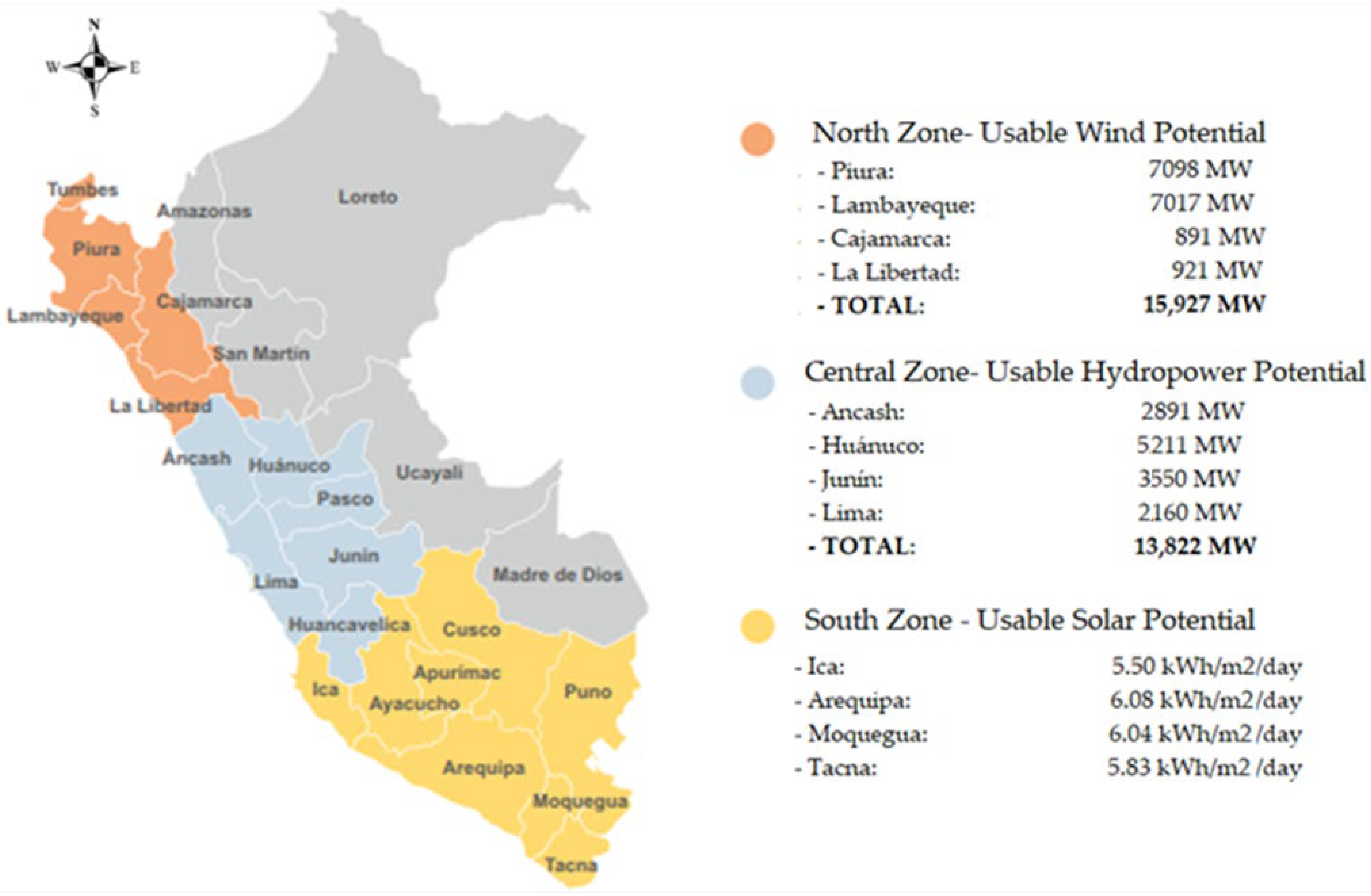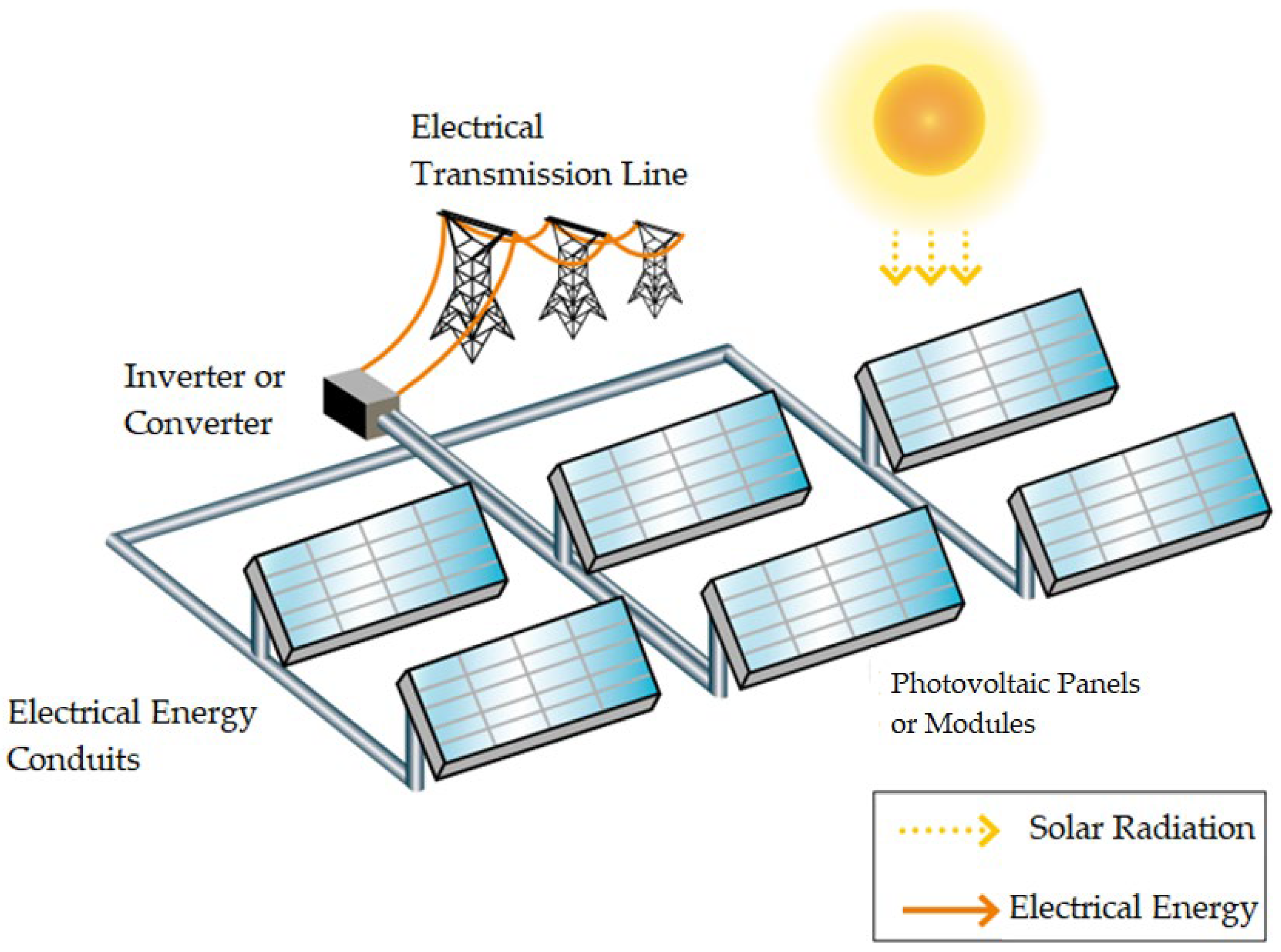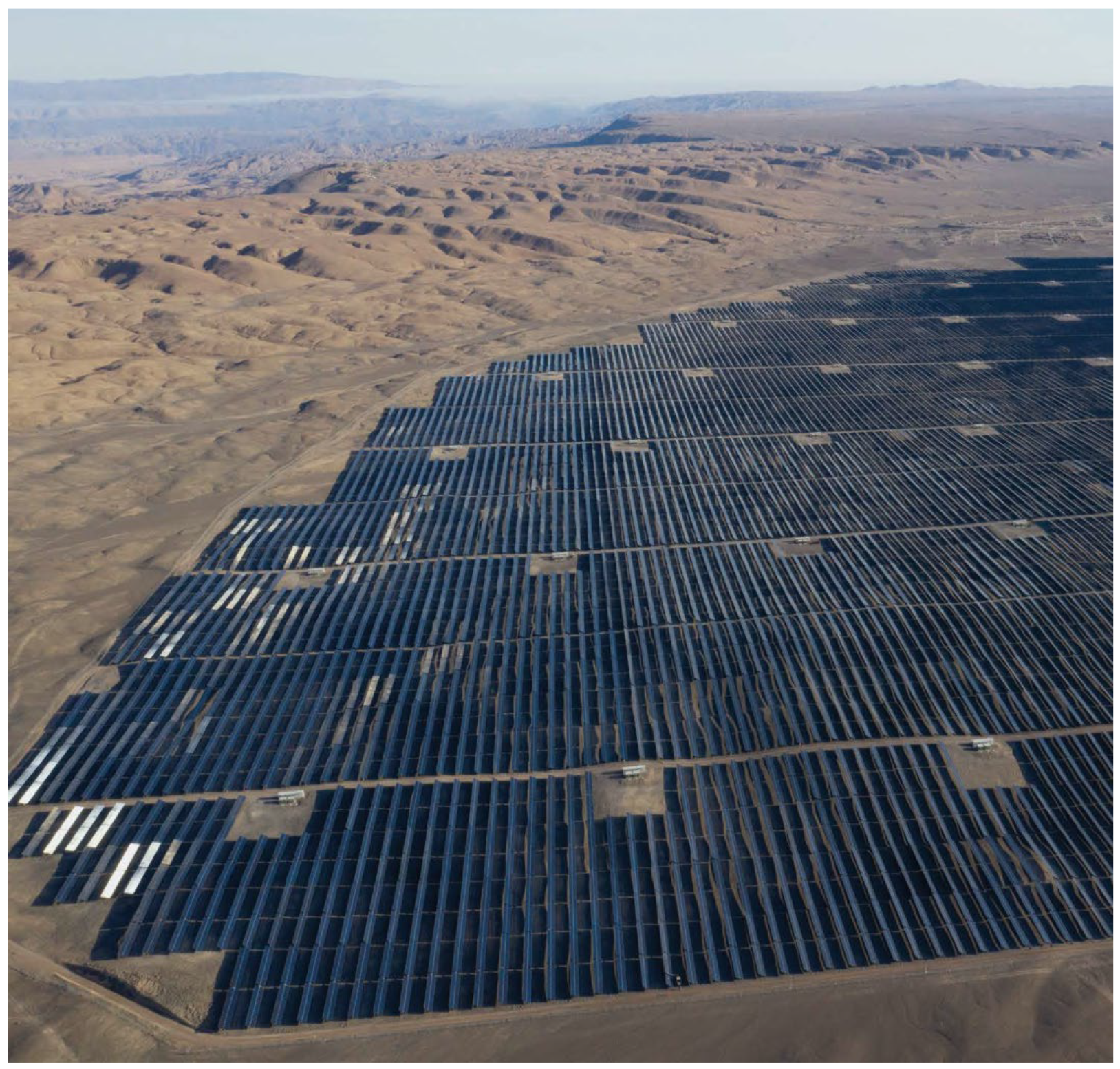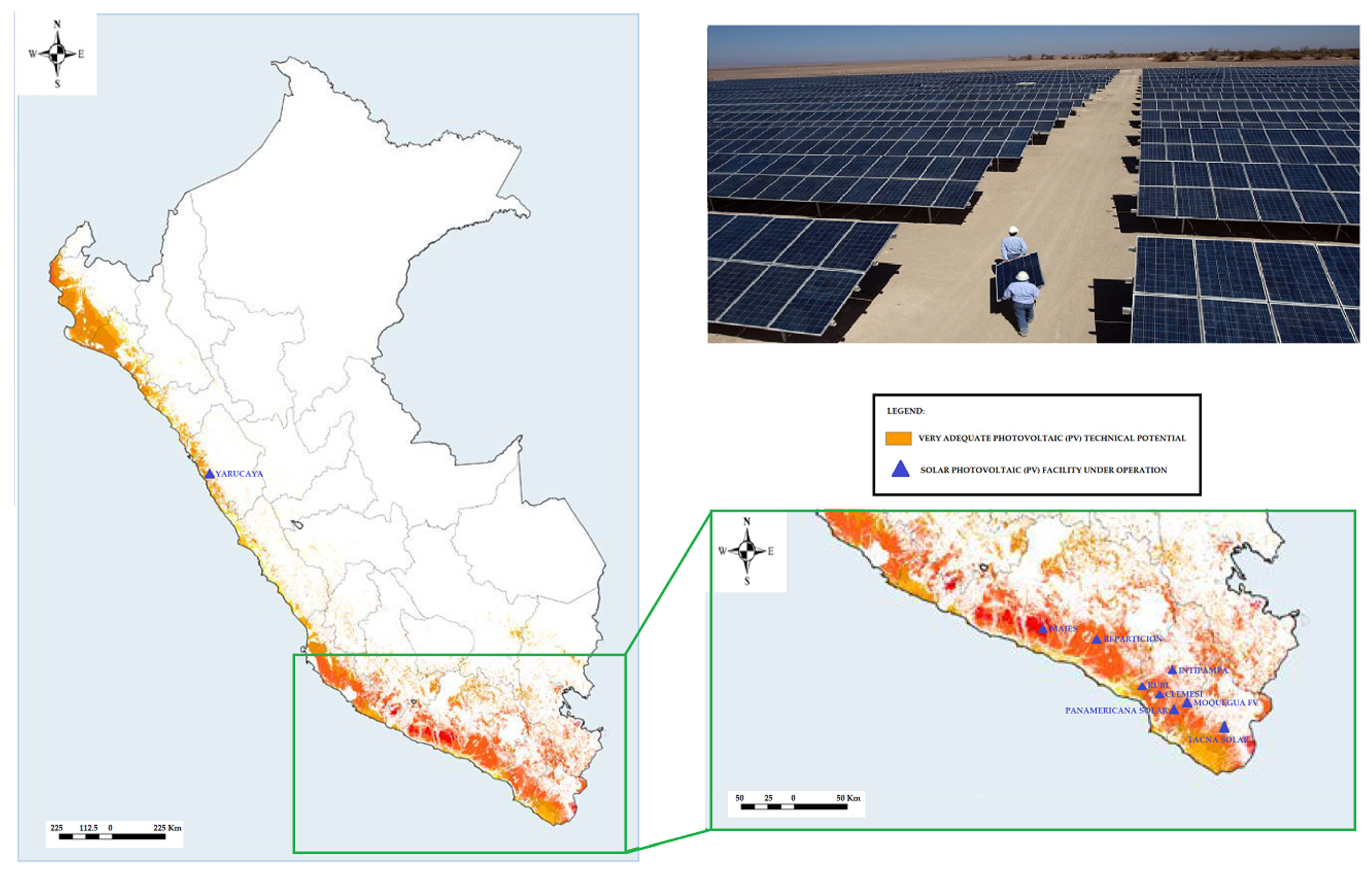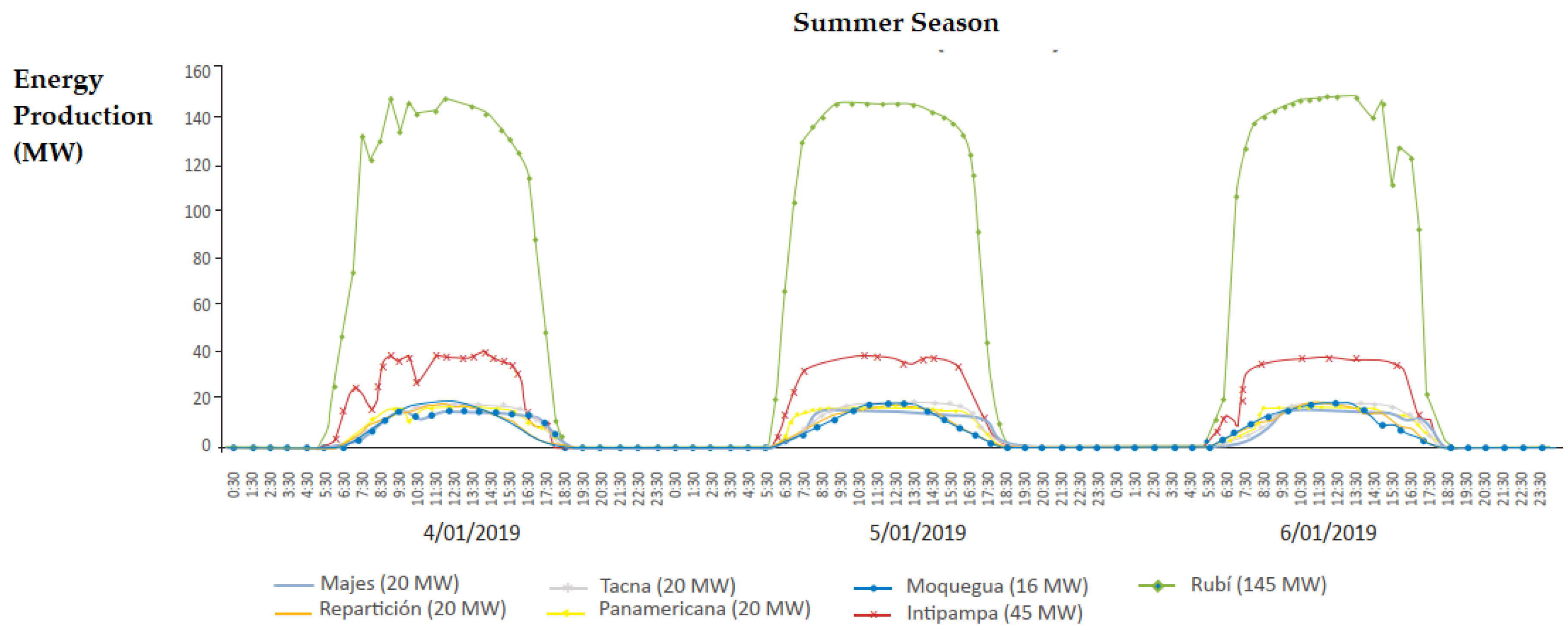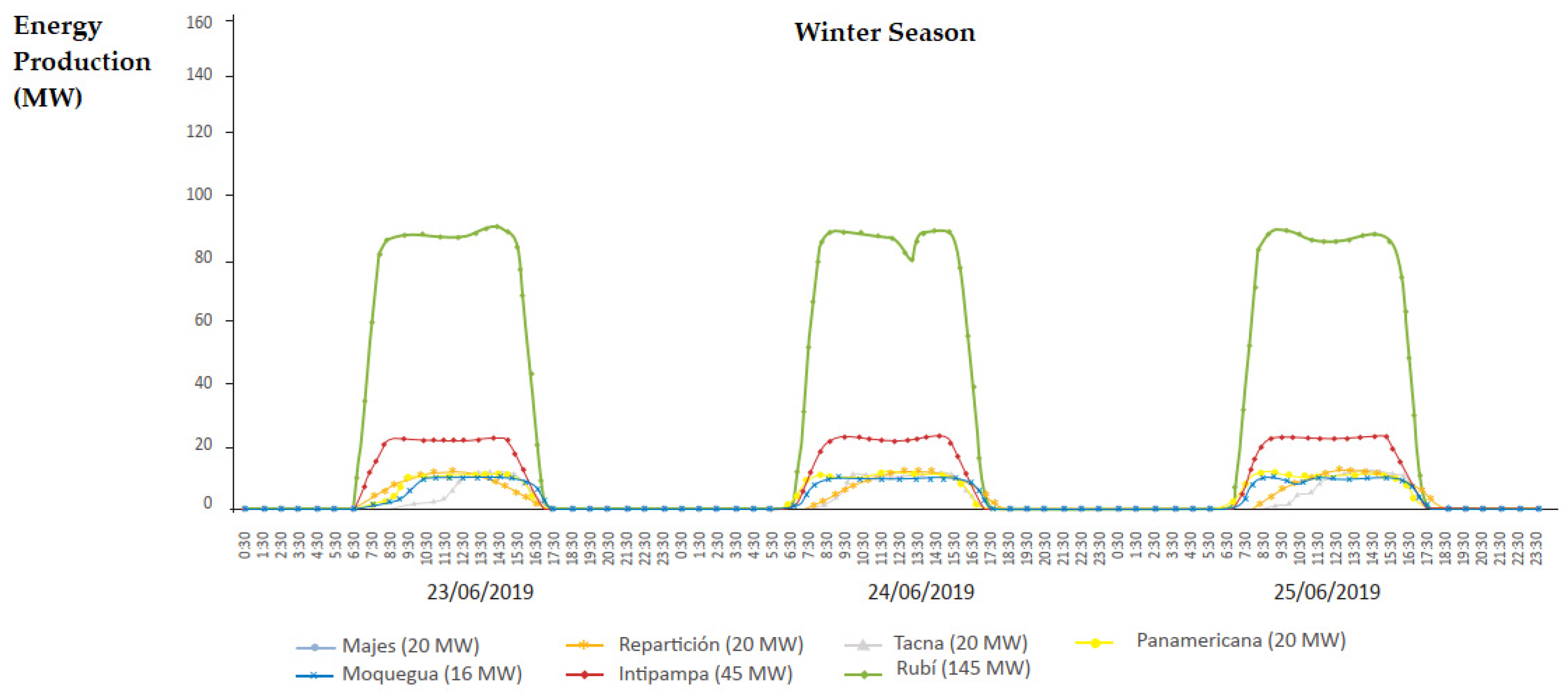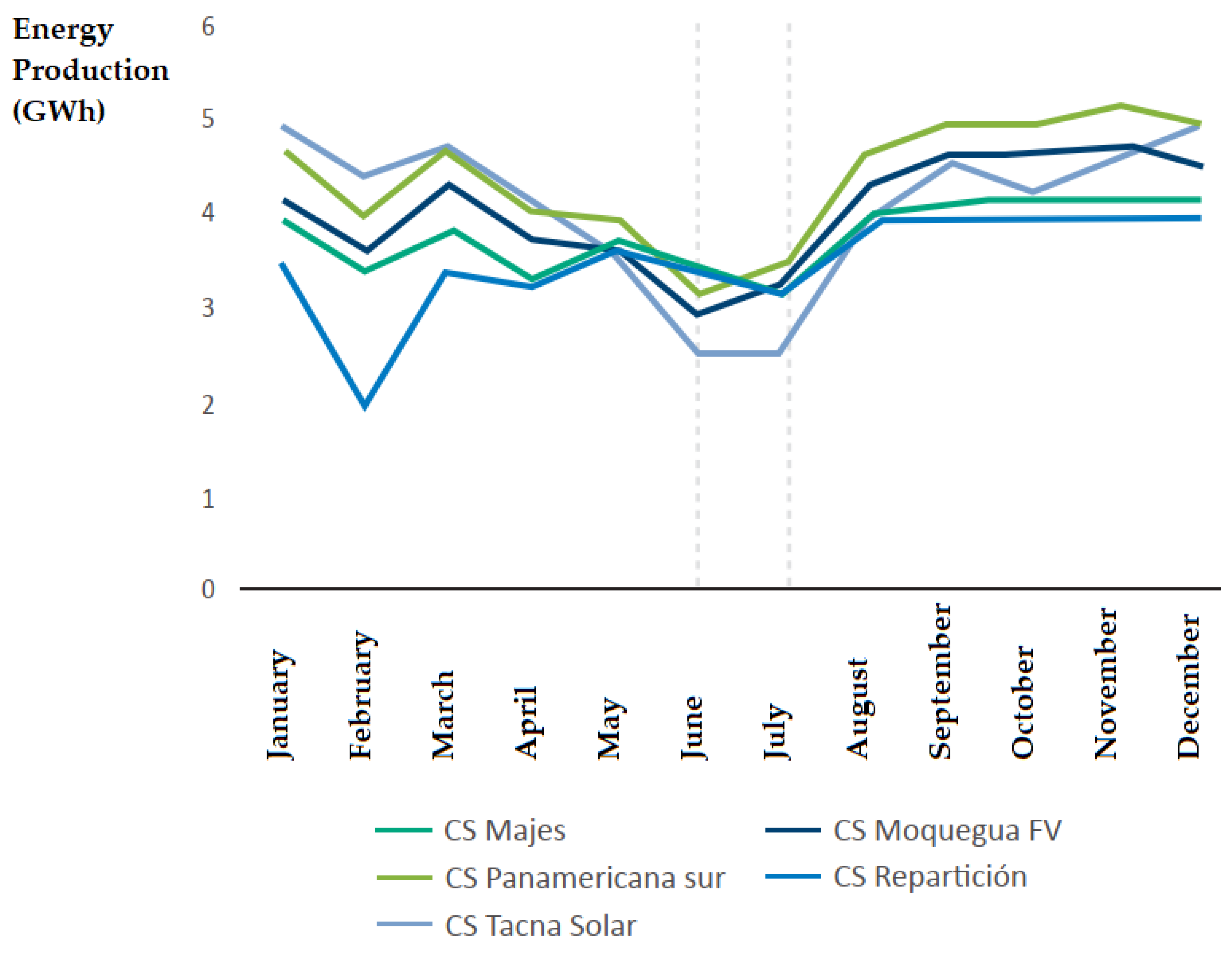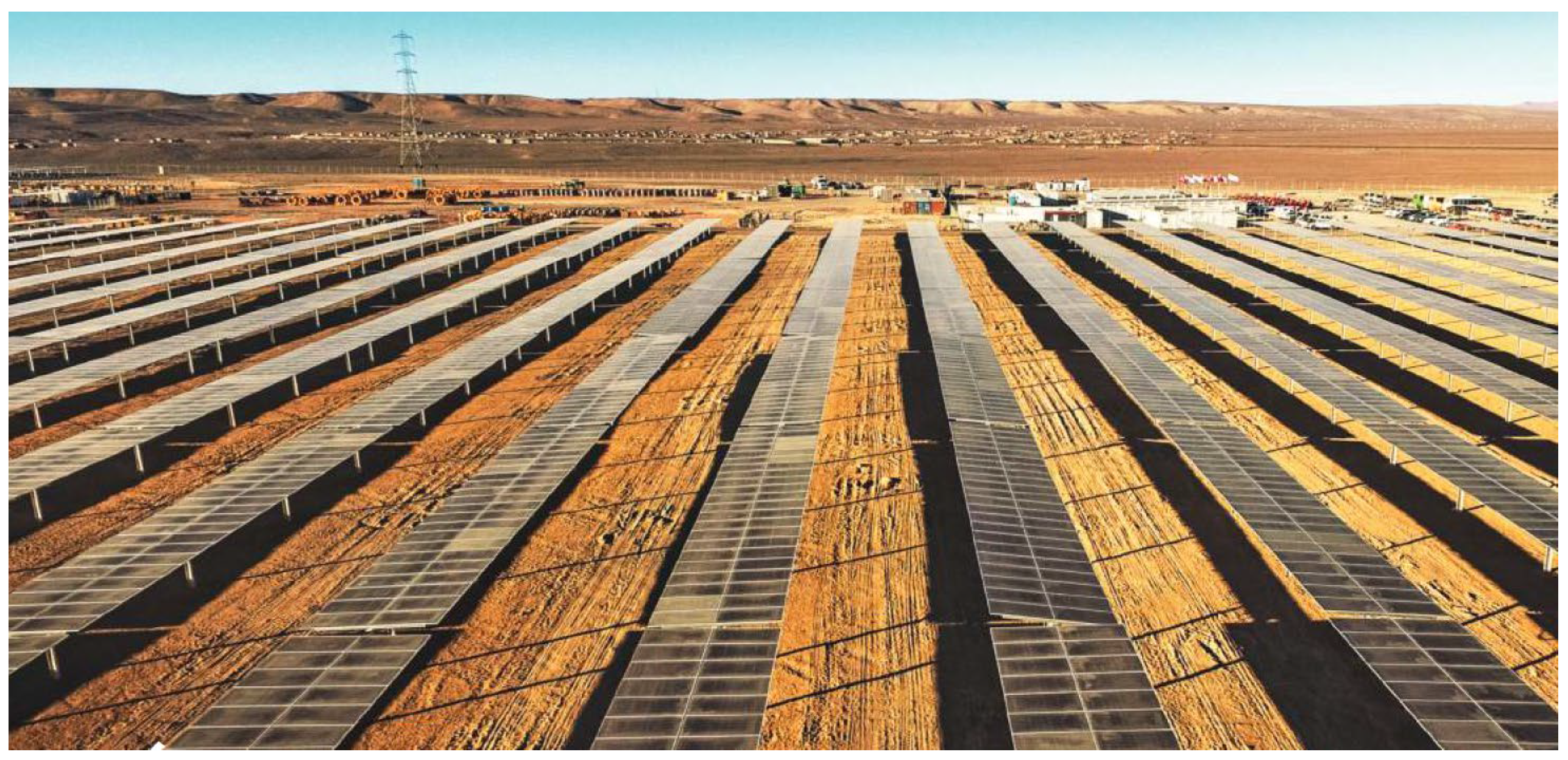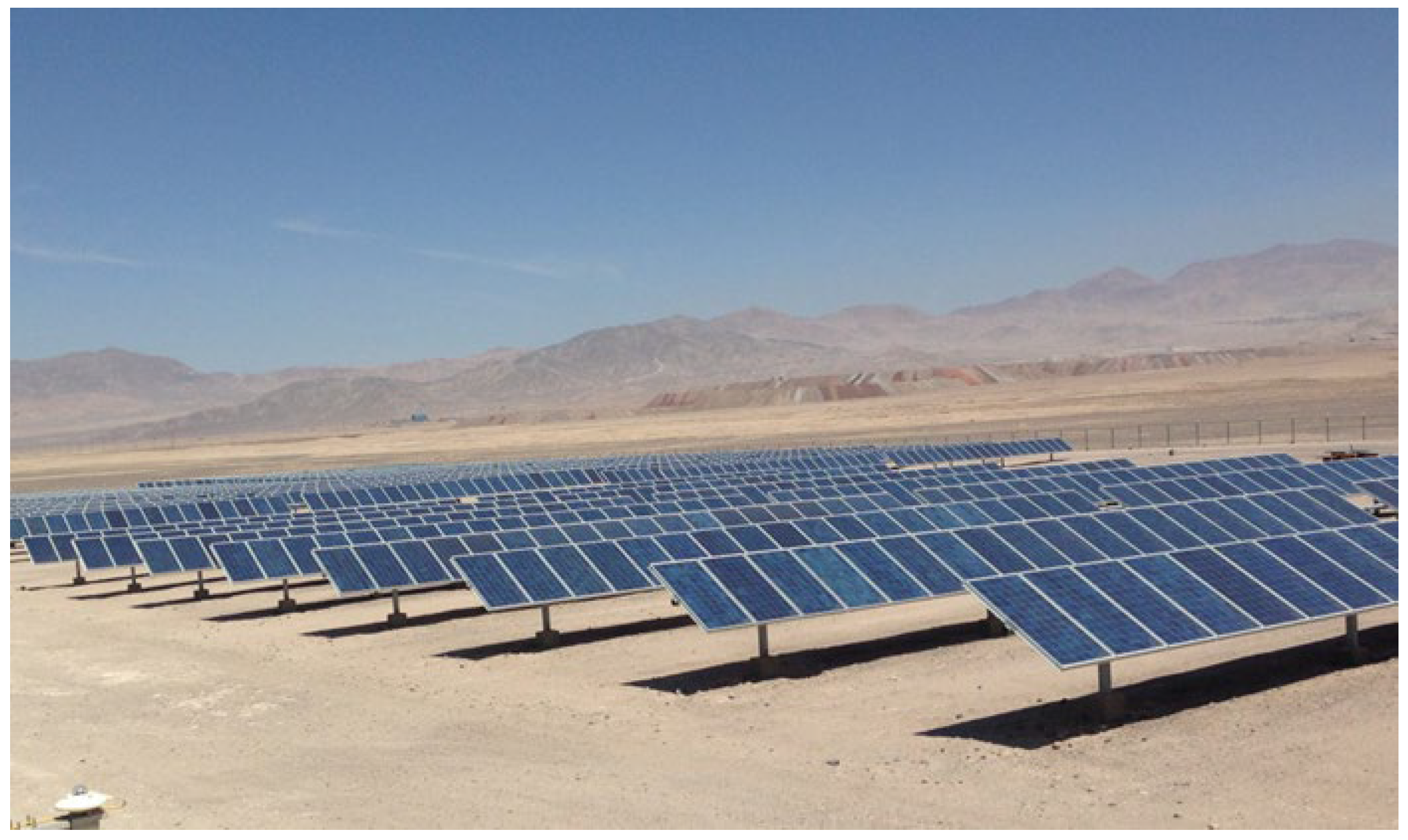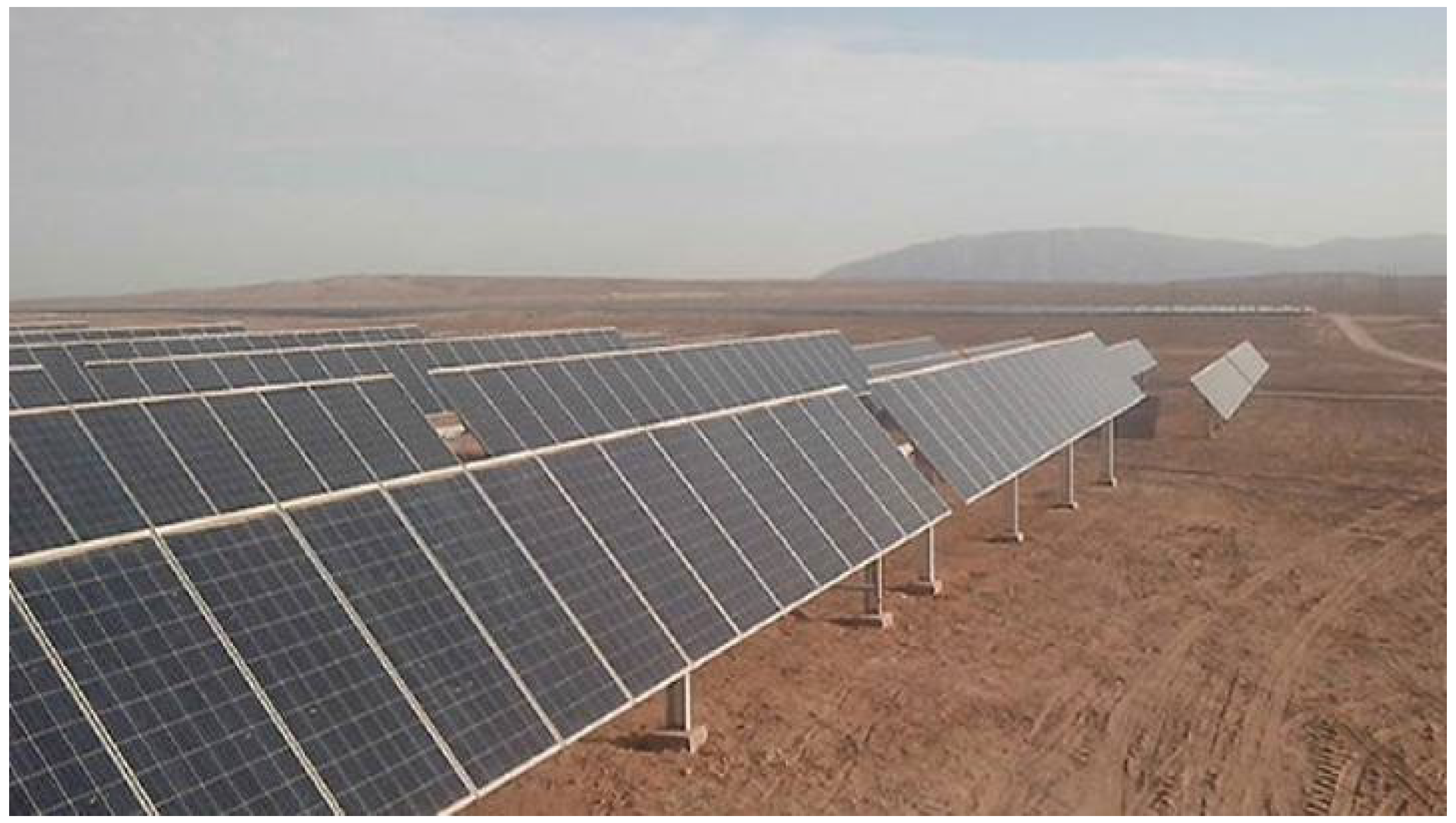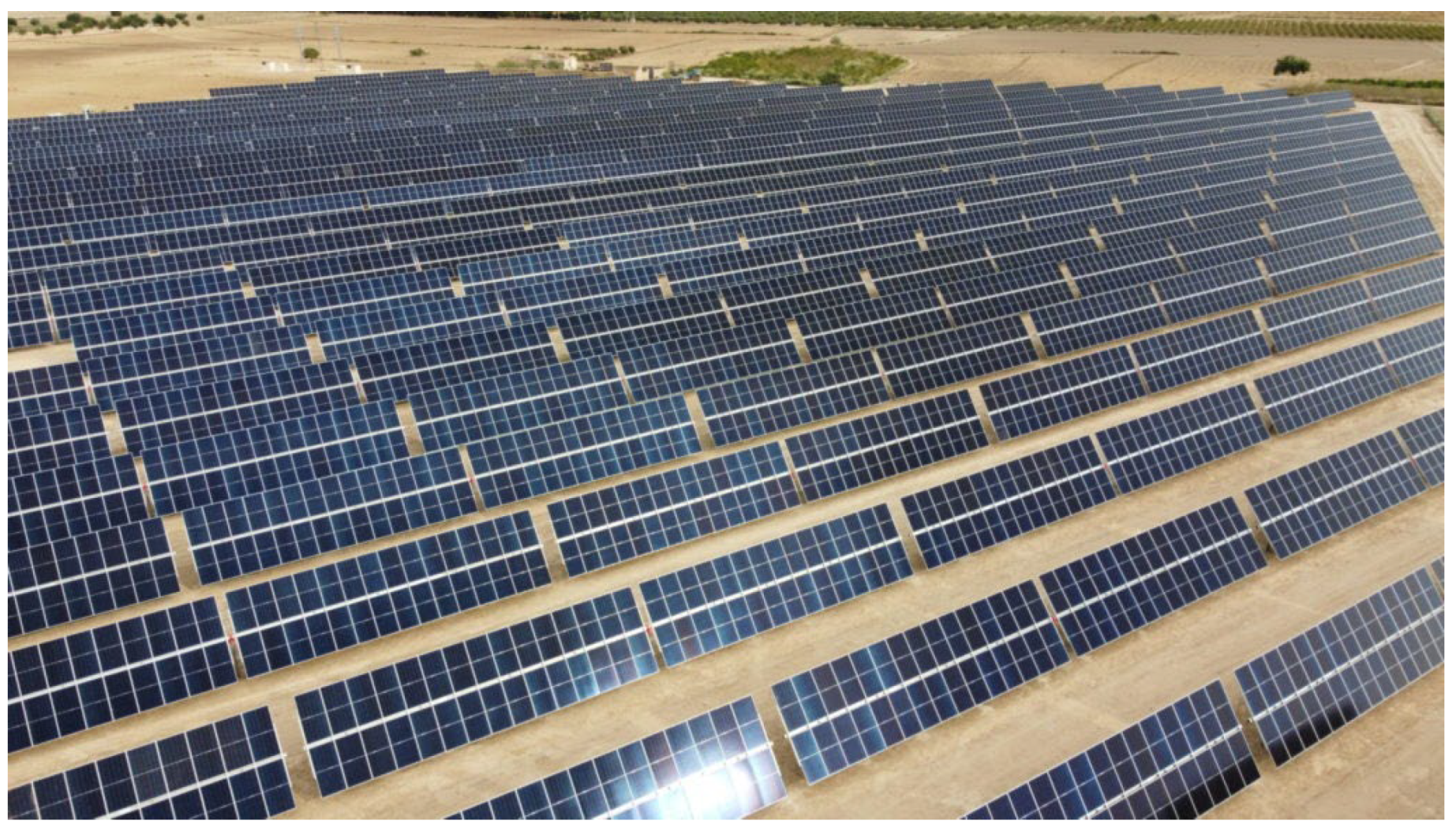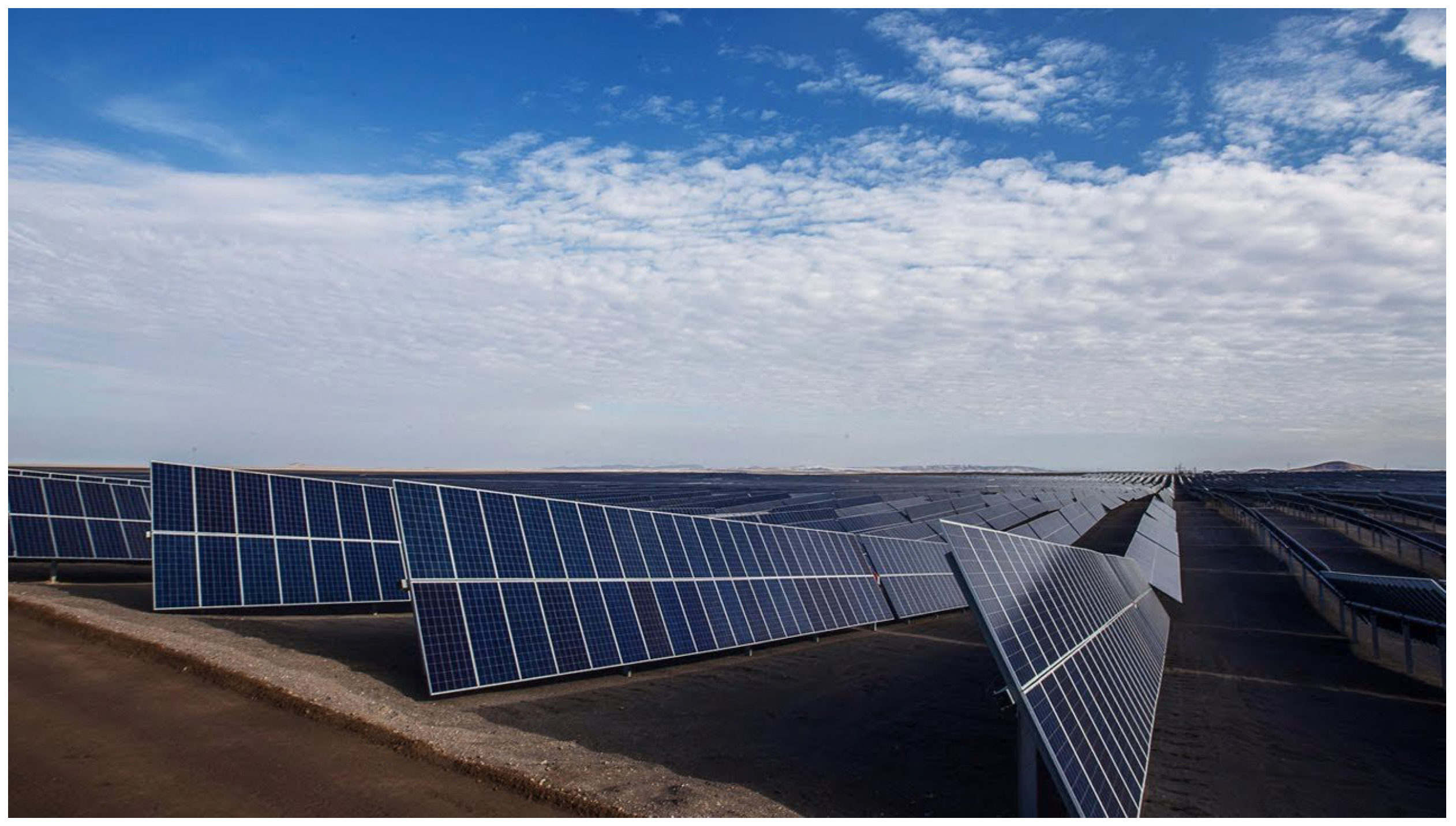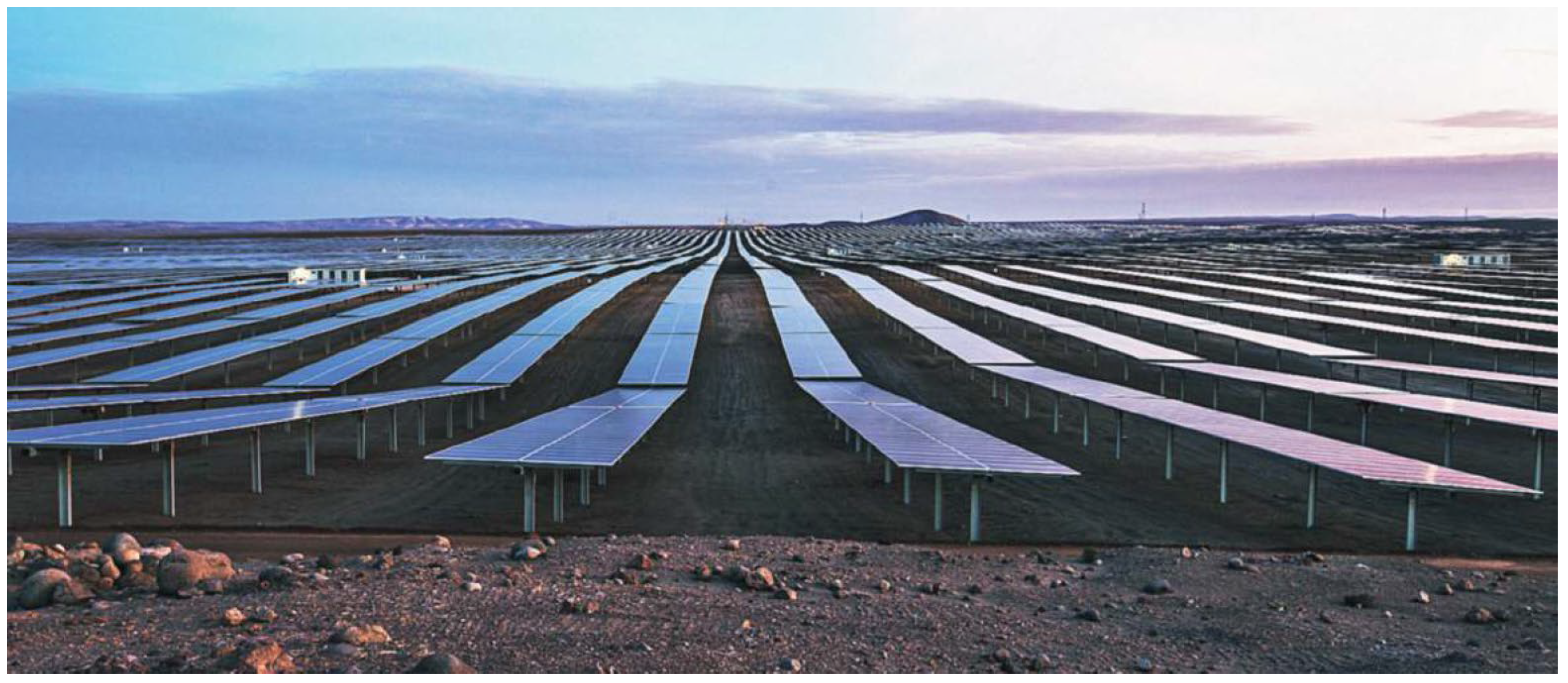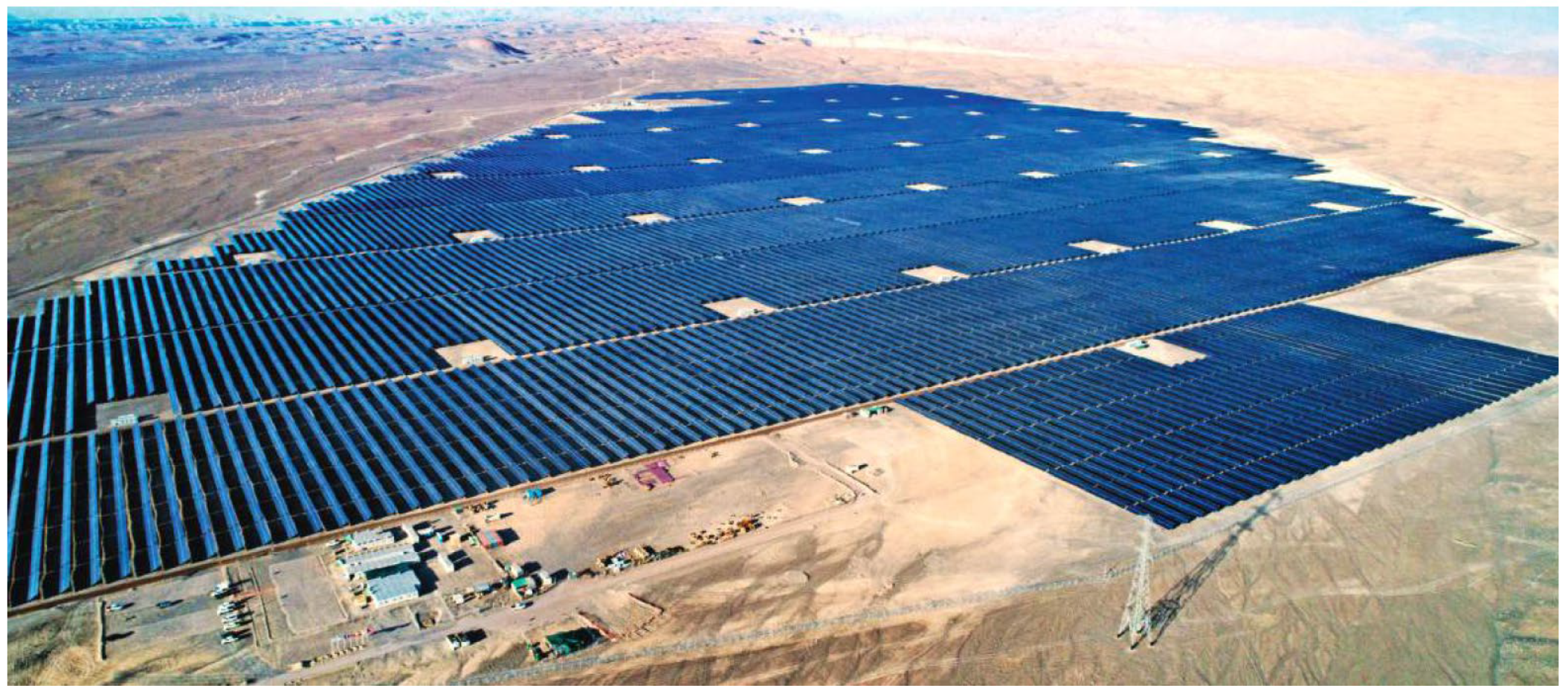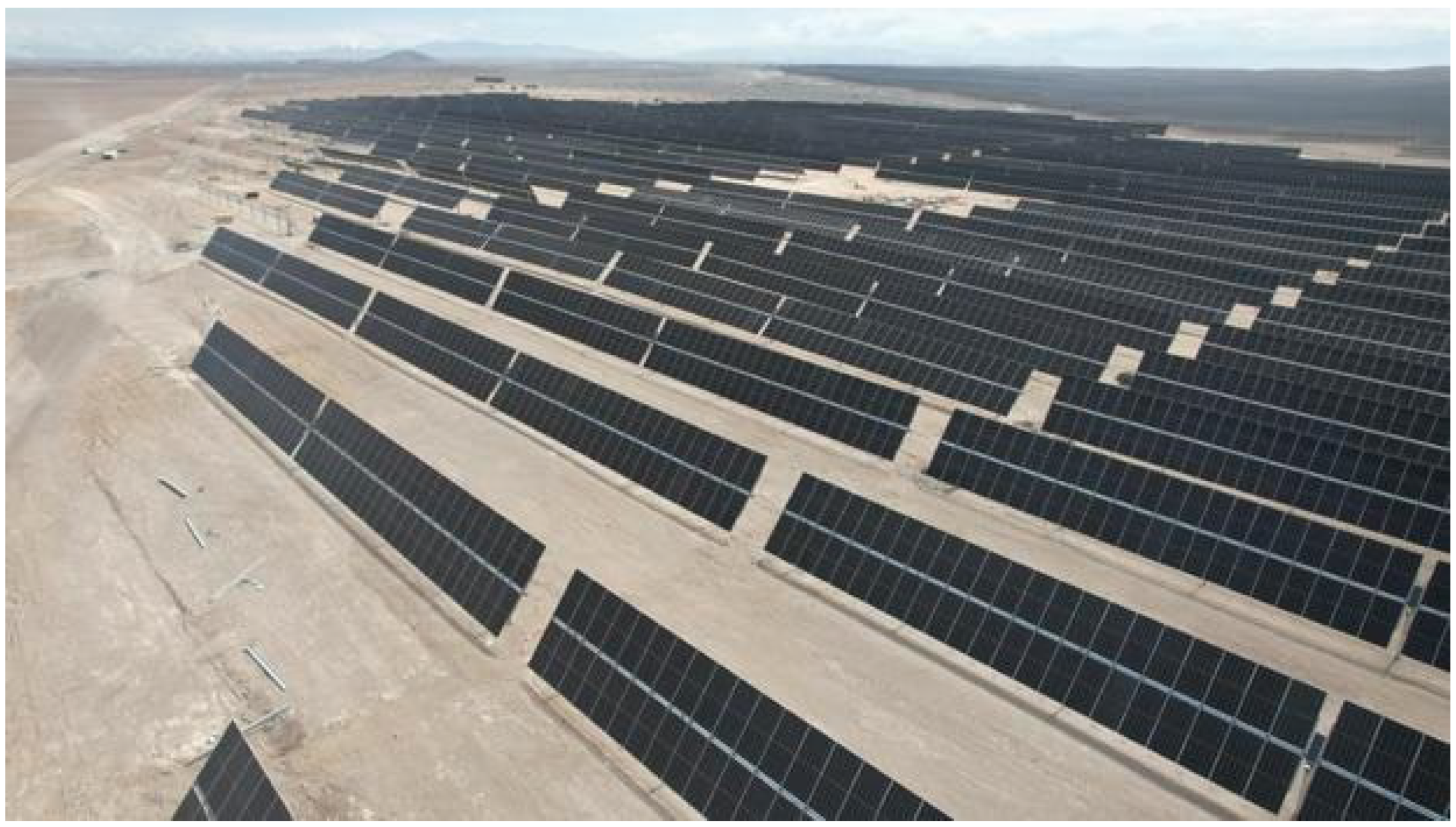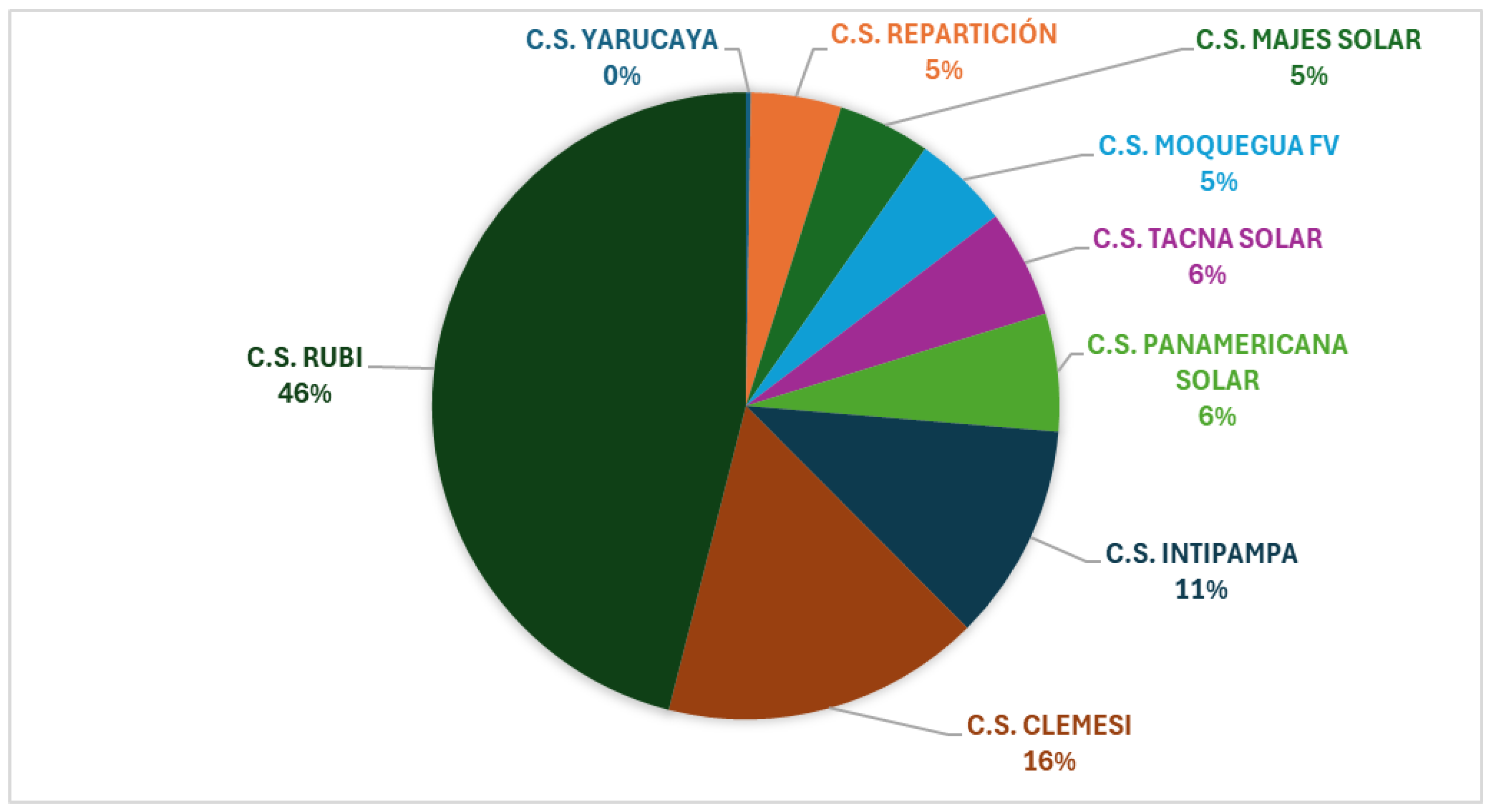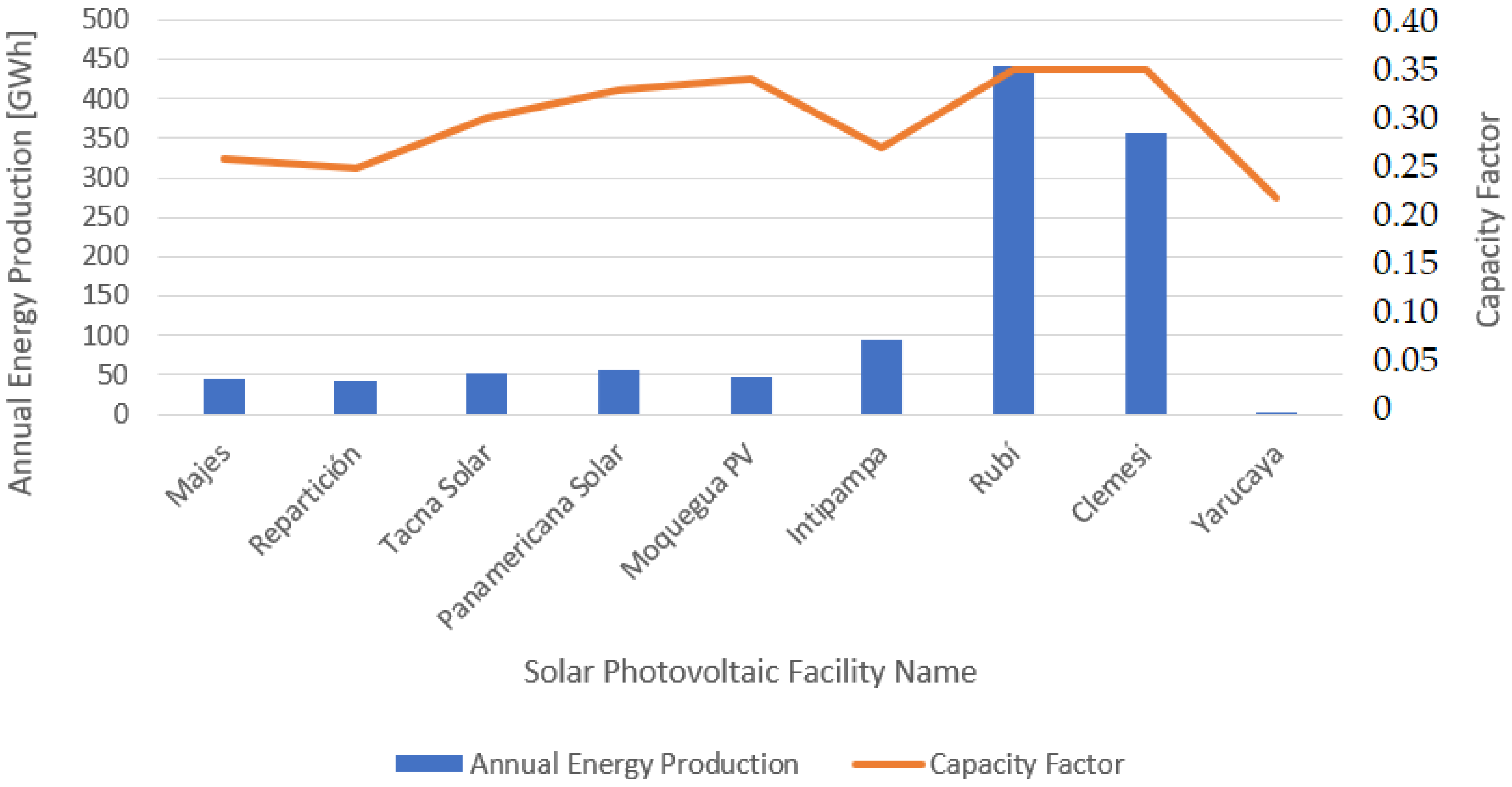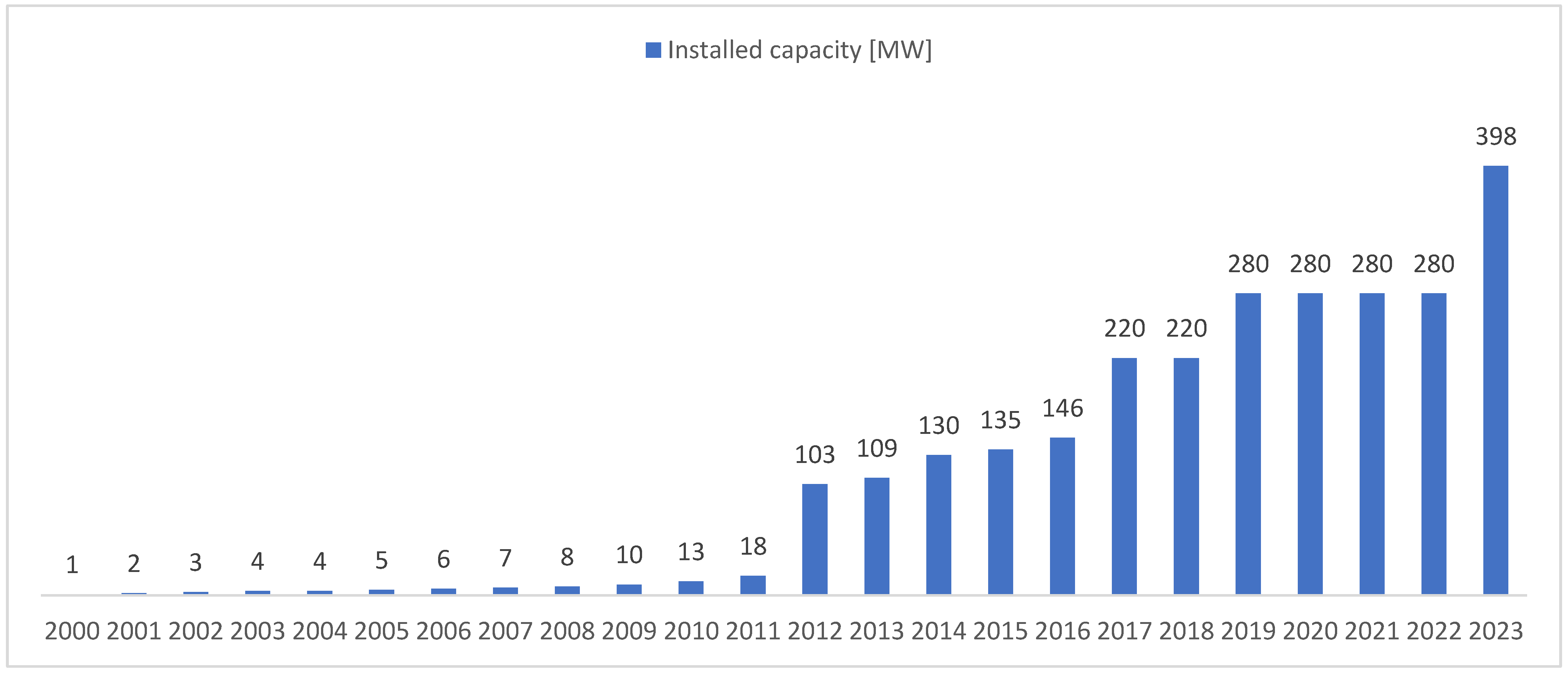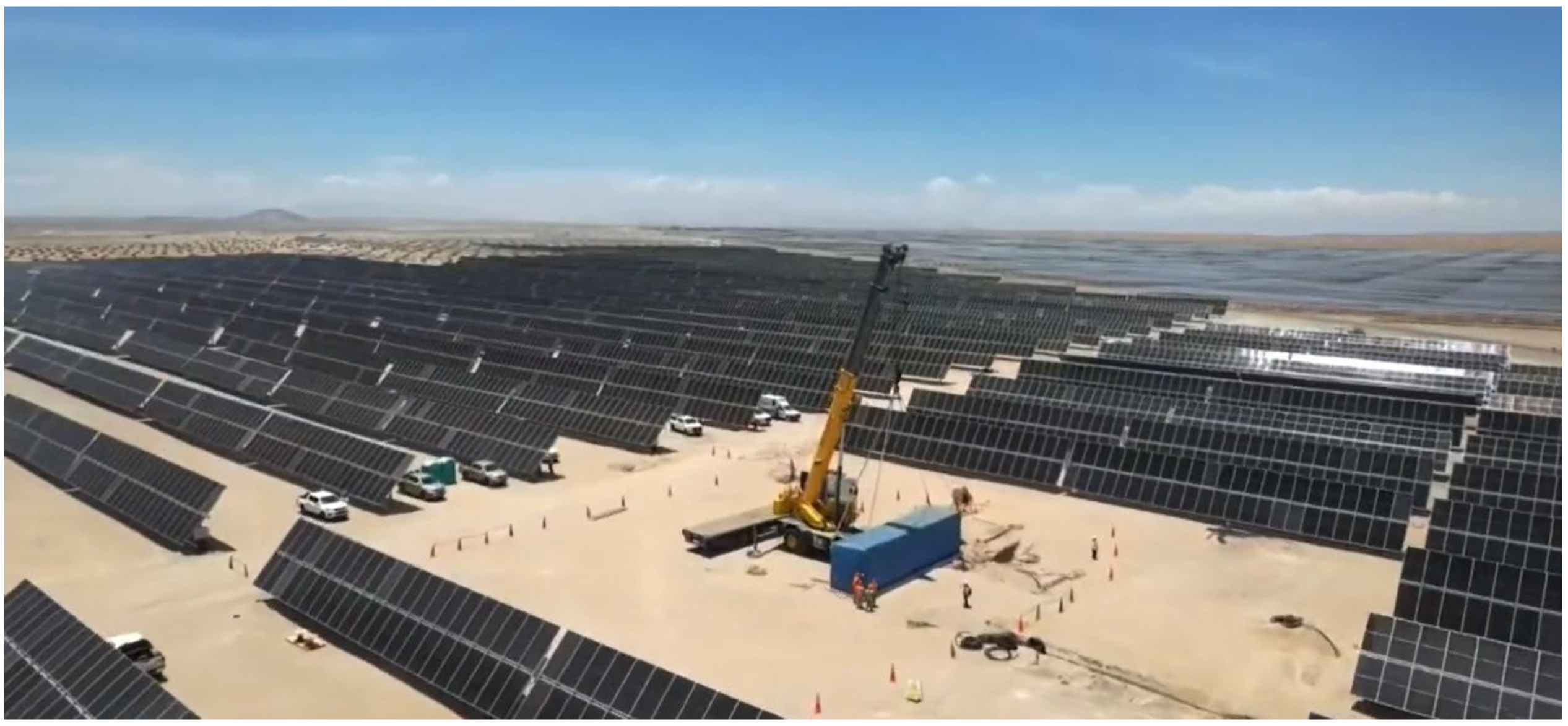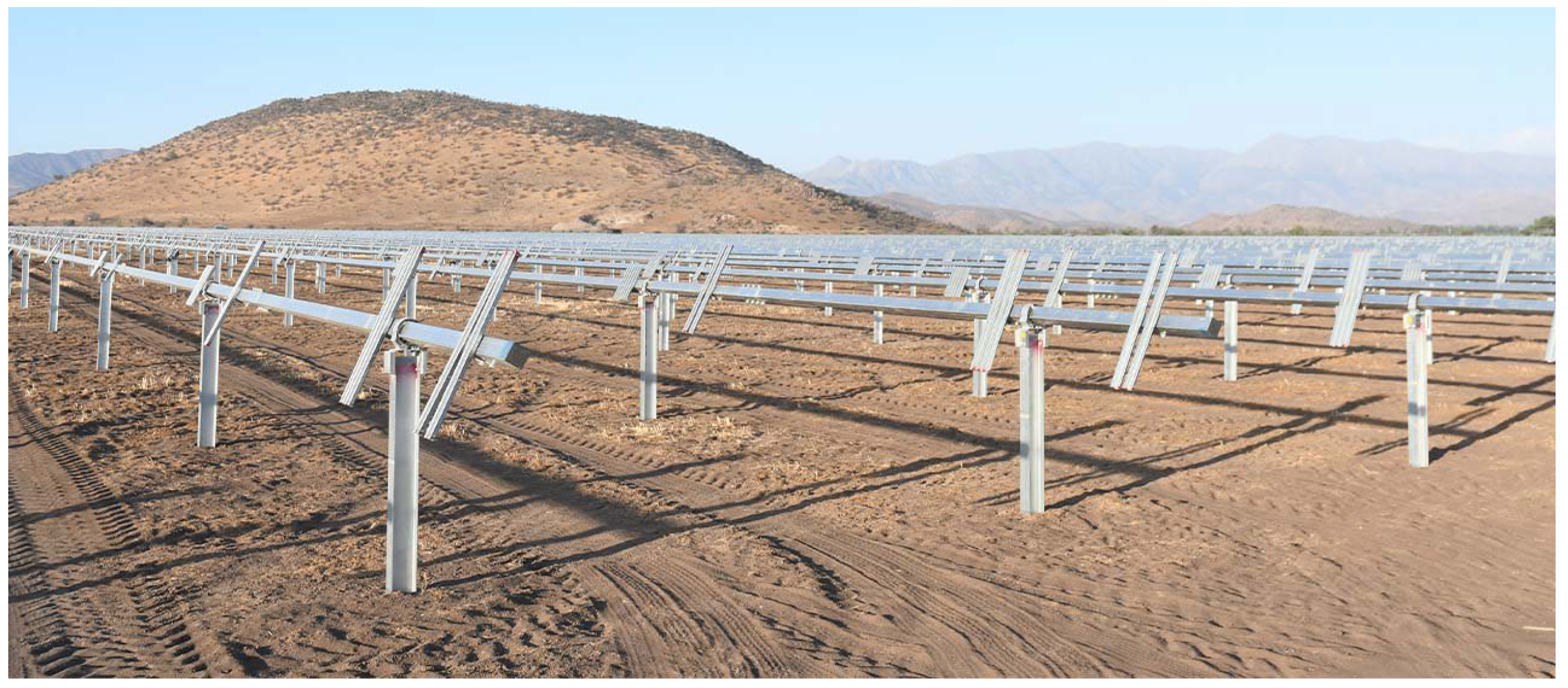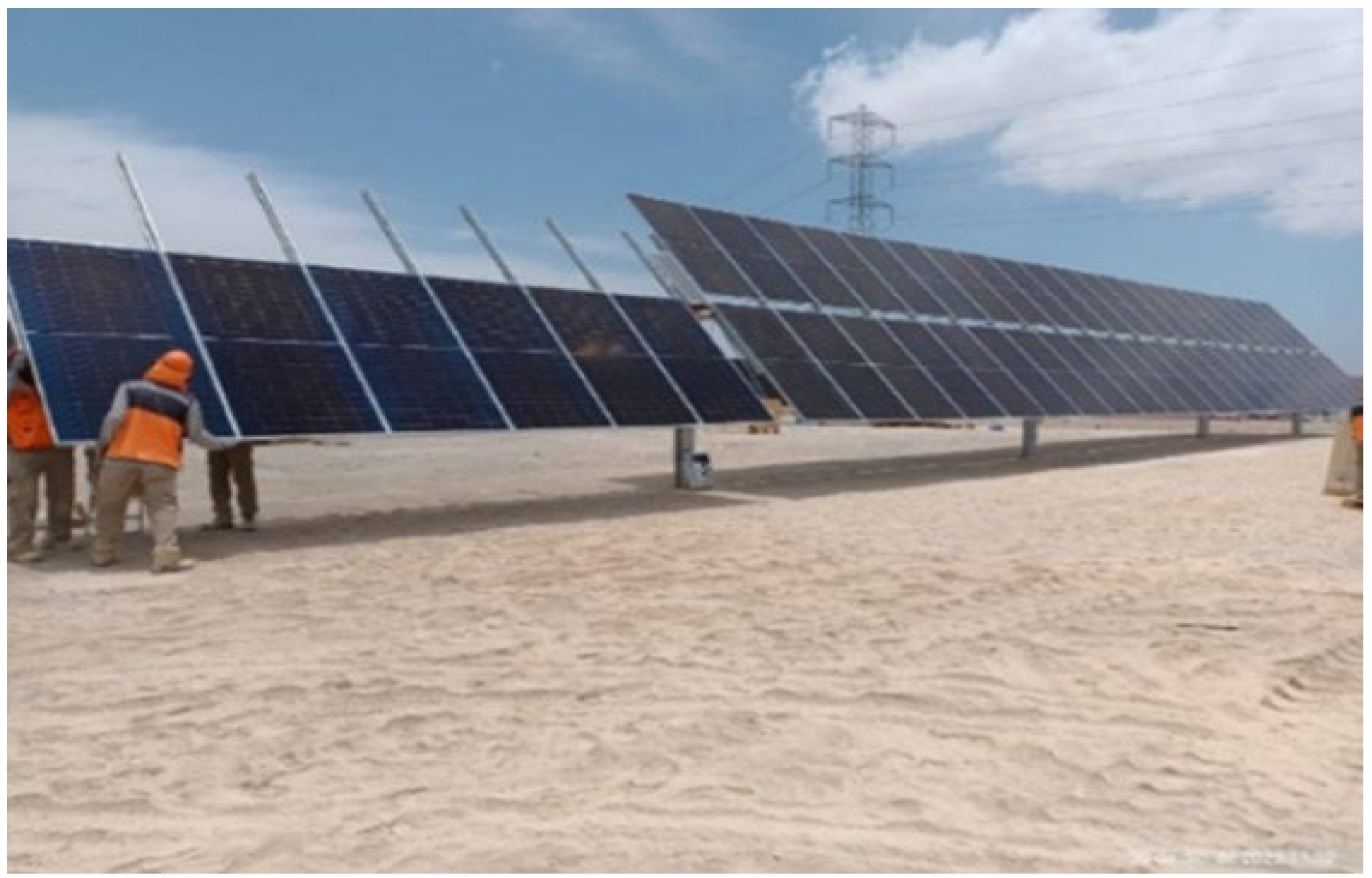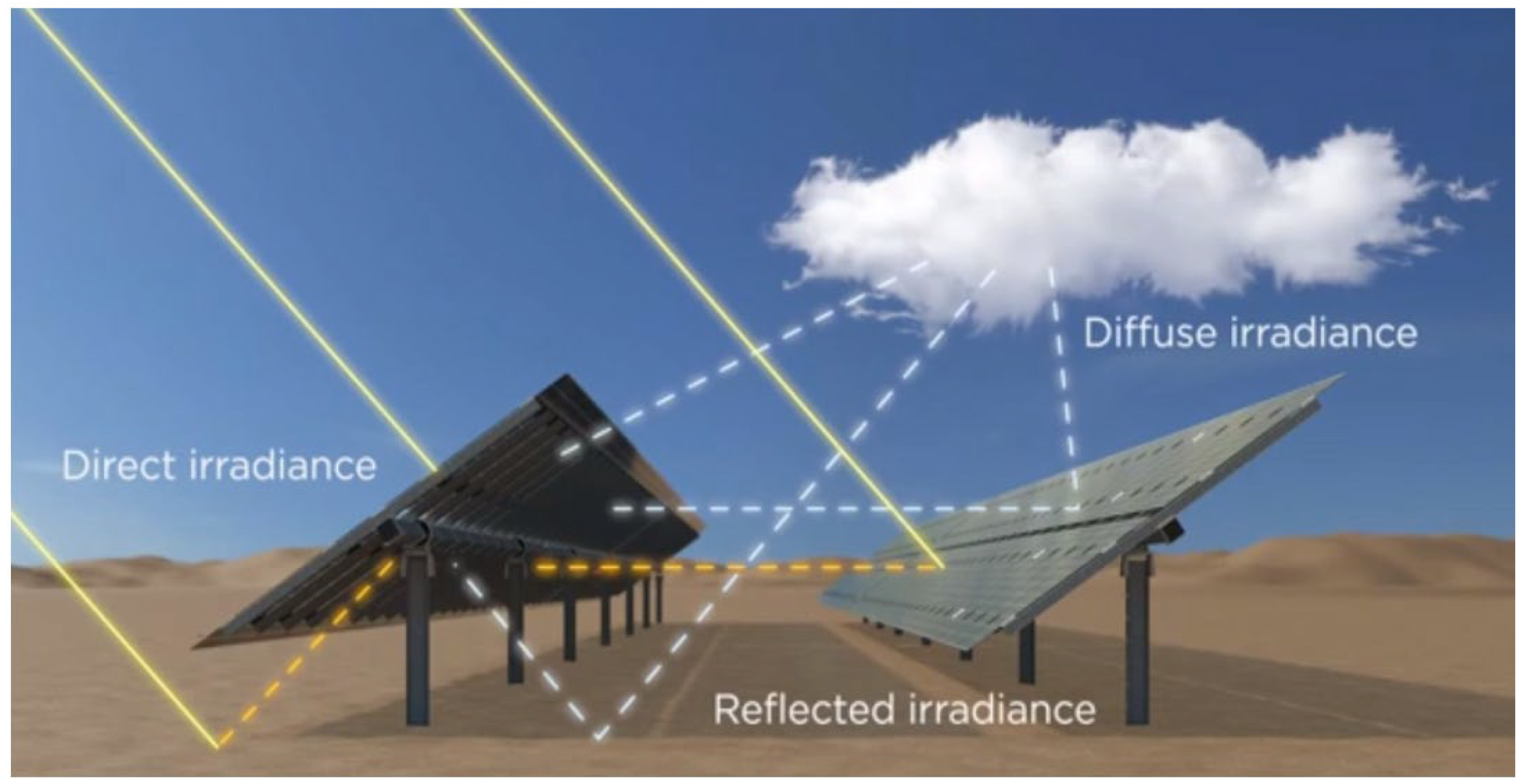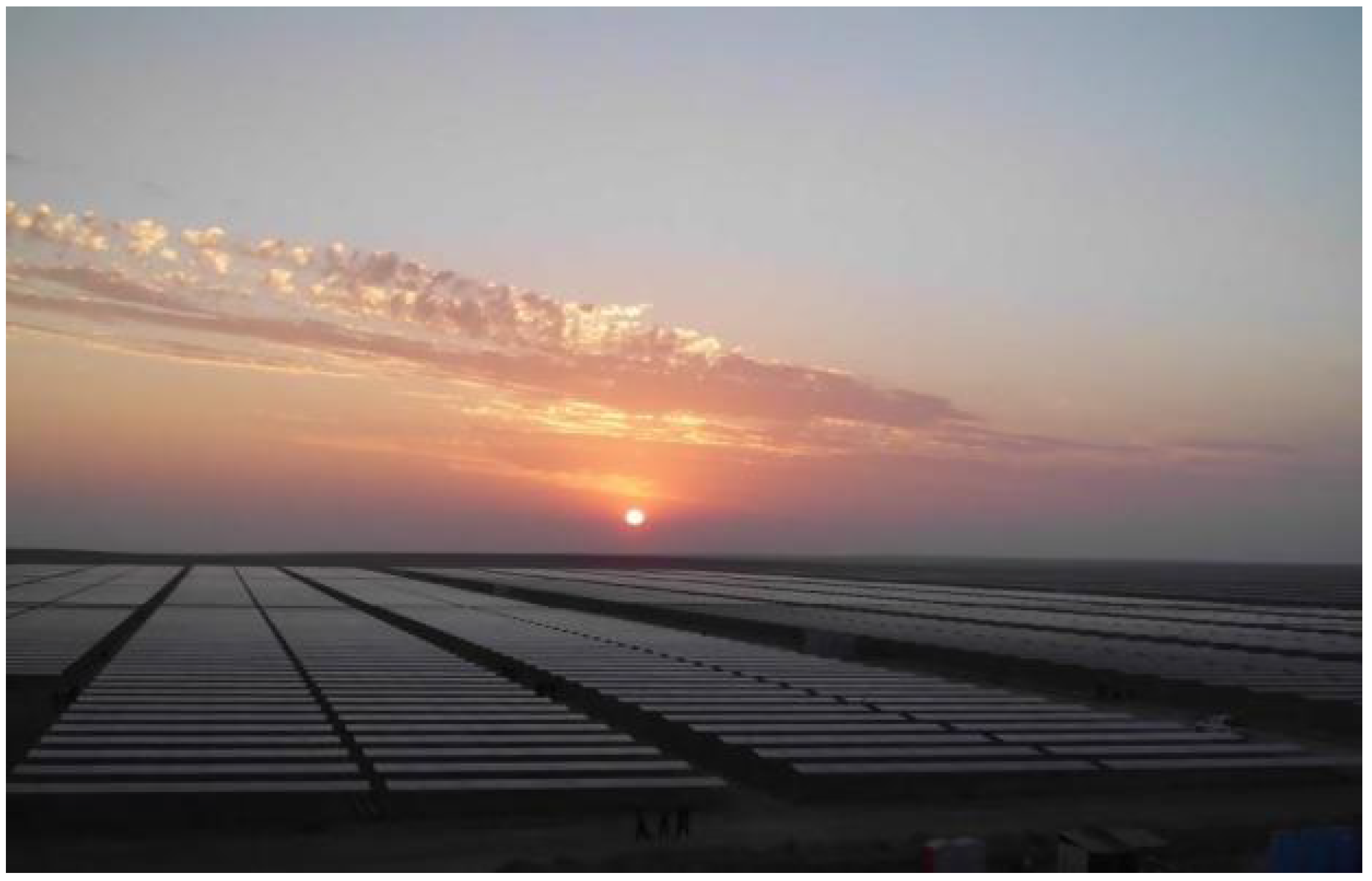2. Potential of Solar Energy Resources in Peru
In Peru, the orographic, climatic, and oceanographic conditions, among other factors, determine the existence of three large natural regions: the coast, the Andes Mountains, and the jungle. The coast is the region limited by the Pacific Ocean and the Andean slopes below 2000 masl. The Andes Mountains are characterized by the presence of peaks and mountains with heights of 6768 masl. The jungle is a region formed by two zones, the Amazonian tropical forest or low jungle and the slopes and valleys to the east of the Andes below 2000 masl known as the high jungle [
1].
The distribution of the solar resource primarily drives the geographical variability of the solar energy yield. The key characteristics of the solar resource are defined mainly by latitude, the presence of clouds, topography, shade, atmospheric aerosol concentration, and air moisture content [
27].
Considering annual variations, the area with the greatest solar energy potential in the Peruvian territory is mainly located on the southern coast (16° to 18° S), where global horizontal irradiation (GHI) of 6.0 to 6.5 kWh/m
2/day is available. Other areas in which high availability of daily solar energy is recorded, with global horizontal irradiation (GHI) of 5.5 to 6.0 kWh/m
2/day, are the northern coast (3° to 8° S) and a large part of the mountains above 2500 masl. In order of importance in terms of their surface area, these include the southern mountain range, the central mountain range, and the northern mountain range. The area with low solar energy values in the territory is the jungle, where values of global horizontal irradiation (GHI) of 4.5 to 5.0 kWh/m
2/day are recorded, with an area of minimum values in the extreme north near the equator (0° to 2° S) [
28].
When explaining the distribution of solar energy in the Peruvian territory, we must take into account various factors that control the climate, such as the Andes mountain range, which shapes the orography of the Peruvian territory; the South Pacific Anticyclone, which produces great atmospheric stability owing to the presence of downward vertical movements in the middle troposphere; the South Atlantic Anticyclone, which provides humidity and feeds the south-east trade winds; the Peruvian cold current in the Pacific Ocean, which reinforces stability in the atmosphere; the Equatorial warm current (El Niño Southern Oscillation—ENSO), which destabilizes the atmosphere on the northern coast in the summer months; the Intertropical Convergence Zone, which generates very active cloud systems; and the Alta of Bolivia, which is associated with convective systems that tend to mainly affect the northern and central mountains and jungle of Peru [
28].
In general terms, in the central and southern coast regions, high values of solar energy occur during the austral summer; however, it is necessary to detail some exceptions. In the coastal strip close to the coast, located below 600 masl, the behavior described above changes during late autumn, winter, and early spring, when this region shows markedly low levels of solar energy and constitutes an area of minima in the territory. At the end of spring, on the desert terraces of Arequipa, Moquegua, and Tacna (13.5° to 18° S and 70° to 76° W) above 1000 masl, the highest annual values of solar energy of the Peruvian territory are reached. This is because they are located above the thermal inversion layer and have clear skies throughout the year. The northern coast, between 3° and 6° S and 80° to 81° W (the regions of Tumbes, Piura, and northern Lambayeque) also presents high values of solar energy during the austral summer; however, the maximum values of solar energy in October and November (spring) are also high in annual terms [
28].
According to the map of solar energy presented in the Global Photovoltaic Power Potential by Country report generated by ESMAP [
29], Peru has considerable and underutilized solar potential. These conditions are mainly concentrated in the southern and northern parts of the country.
Figure 4 shows the global horizontal irradiation (GHI) map of Peru. The irradiance level is the most crucial parameter for calculating energy yield and evaluating the performance of flat-plate photovoltaic modules. It is also the most widely adopted technology in the field.
Currently, the country has nine solar photovoltaic facilities in operation (information correct as of March 2024). All these solar PV facilities are integrated into the SEIN. Eight are found in the southern regions of (i) Arequipa (Majes and Repartición), (ii) Moquegua (Moquegua FV, Intipampa, Rubi, Panamericana Solar, and Clemesi), and (iii) Tacna (Tacna Solar) [
6] (
Figure 5), and one is located close to the capital city of Peru, specifically in the Lima region (Yarucaya).
These geographical areas of Peru are characterized by an average daily solar irradiation of over 6.0 kWh/m
2/day, as well as capacity factors between 22% and 35% [
6]. This situation facilitates efficient energy transformation, which is particularly intensified during peak hours, thereby improving SEIN’s economic commercial conditions.
The production of solar PV energy is conditioned to irradiation characteristics, which can fluctuate by season or be affected by the presence of clouds. However, solar PV facilities present a very similar hourly behavior, so the electricity generation increases accordingly [
31].
Figure 6 and
Figure 7 show the average hourly solar PV energy generation pattern in Peru according to the annual seasonal period and some solar PV facilities under operation in the southern region of the country in 2019.
Figure 6 corresponding to the summer season shows the time of the day when the greatest amount of electrical energy is generated in solar photovoltaic facilities in Peru (between 5:30 a.m. and 6:30 p.m.). Also,
Figure 7 corresponding to the winter season shows the hours of the day when the greatest amount of electrical energy is generated in solar photovoltaic facilities (between 6:30 a.m. and 5:30 p.m.).
This behavior is a result of the reduced climatic instability in the southern region, which is attributed to the presence of aerosols and water vapor that create a dry climate with low cloud cover. Consequently, solar radiation remains stable for at least seven hours per day (in winter), facilitating consistent energy production between 8:30 a.m. and 01:30 p.m. Although electricity generation commences between 6:00 a.m. and 6:30 a.m., production continues until 06:00 p.m.
Moreover, seasonal variations can be observed based on the time of year. The winter season typically yields the lowest energy output, whereas the summer season has the highest energy generation. Specifically, the reduction in solar energy generation during the winter season can range from 30% to 50% compared with the summer months (See
Figure 8).
All the solar PV facilities currently functioning are in the desert territory of Peru. In these locations, relevant amounts of solar irradiation are generated during much of the day (
Figure 9). Overall, Peru’s solar resources have been estimated at a useful potential of 25 GW, and only 2% of the potential has been used as of 2024.
The usable potential study considers the technical energy capacity and production of a specific technology given resource potential, device performance, terrain restrictions, ecosystem attributes, and land-use limitations. The information to be considered in the usable potential estimation includes [
32]:
Minimum resource constraints (4–5 kWh/m2/day),
Maximum allowable terrain slope (3–5%),
Power density for a given technology (25–30 MW/km2),
Maximum distance to transmission lines (5 Km),
Maximum distance to roads (5 Km), and
Land exclusion types (agricultural, forest, urban, water bodies, wetlands, and environmentally protected areas).
The non-available land area in the southern region of Peru is likely restricted by steep topography and the distance to transmission lines and roads, while the land area in the Amazon region is likely restricted by land type (forest) and insolation values [
33]. The useful solar energy technical potential for Peru is equivalent to 25,000 MW.
Table 2 shows details of the geographical areas of the country with the greatest average solar energy, where values between 4.00 and 7.00 kWh/m
2/day are recorded.
Table 2 shows that the geographical areas of the country with the greatest solar energy potential are Arequipa, Moquegua, Tacna, Tumbes, Piura, and Ica. They highlight the relevant potential of Arequipa, Moquegua, and Tacna, with an average solar radiation of 250 W/m
2. These regions are part of the Coast Desert of Peru, in which nine photovoltaic solar energy plants are in operation in 2024. Also noteworthy are the northern regions of the country (i.e., Tumbes and Piura and part of the Sechura desert), which, despite their attractive solar resources, have not been used to date. The Ica region also stands out for its attributes of renewable wind and solar resources, with wind farms already in operation but no photovoltaic solar energy plants to date. Finally, the Lima region has one solar photovoltaic facility operating called Yarucaya, and it is expected that more solar energy projects will be constructed in this region.
4. Discussion
4.1. Registered Progress
4.1.1. Potentialities and Limitations of Solar Photovoltaic (PV) Energy in Peru
Solar PV energy advances on a large scale have already been carried out in Peru, as they are environmentally friendly and an attractive option to apply in different geographical locations with solar resource potentialities. In terms of the knowledge acquired about solar energy projects in Peru since 2012, the key potentialities and limitations are shown in
Table 18.
The key potentialities shown in
Table 18 indicate that the ecosystem damage to land from this clean-energy source is limited. It is also shown that its functioning is not complex to implement, and it also produces a large number of jobs, mainly during the construction process. Some limitations are observed, considering that it is a fluctuating energy technology, restricted to hours of daylight, and it is cannot be applied in lands of heritage, protected environmental zones, and/or archaeological areas.
Table 18 above shows the main benefits offered by solar energy. However, its implementation also imposes challenges that must be faced. The main challenges are unavailability (or intermittency), its large-scale integration, and the impact it can have on the rates paid by users.
An obvious disadvantage of solar energy is that its supply is intermittent. Photovoltaic cells do not work during the night, although most electricity is demanded in daylight hours when sunlight is intense, and they are less effective when clouds are present.
Intermittency is defined as the unplanned unavailability or interruption of electricity generation from some renewable energy sources such as wind and solar, which, by definition, fluctuate. Solar energy’s intermittency depends on the radiation level in a certain geographical area. It generally has a diurnal and seasonal pattern, that is, it reaches greater intensity during the day and in summer. Furthermore, seasonal intermittency is greater the further away you are from the equator. Diurnal and seasonal patterns provide some predictability in solar generation; however, radiation can be affected by other weather conditions that are difficult to predict, such as cloud cover and the composition of the atmosphere. Thus, a thick cloud layer can absorb available solar radiation, thereby decreasing energy production [
35].
The operation of the current nine solar PV facilities conforms to the support of future solar energy investments to be implemented in Peru. The knowledge acquired to date has allowed construction companies to work in an environmentally friendly way during the implementation of solar energy projects. Experience has also been acquired in environmental impact assessment (EIA) studies and acquiring socio-environmental licenses for operation.
The advances in solar energy in Peru are helping the clean transformation of the energy matrix; however, its application is still in the early stages despite the enormous potential available [
36].
4.1.2. New Technologies Applied to Solar Photovoltaic (PV) Energy Projects in Peru
Solar facilities are optimizing their photovoltaic panel inspection processes with the help of drones, especially those located in places where high solar radiation makes manual field surveys even more difficult for personnel. The integration of drones allows solar energy facility operators to decrease surveys by 70% compared with conventional human techniques. Traditional surveys of photovoltaic solar facilities entail the review of panels one by one with the human use of a laser temperature device. After identifying faults in solar panel arrays, field workers register the positions of the panels for repair or replacement. Considering the large scale of these solar photovoltaic facilities, these conventional techniques are inefficient for operation and maintenance field operators.
The use of technological advances in the Industry 4.0 paradigm, such as the integration of drones, also known as unmanned aerial vehicles (UAVs), increases the efficiency and precision of inspections of photovoltaic panels in solar plants [
37]. Drones equipped with thermal cameras can carry out surveys of vast zones of photovoltaic solar facilities, collecting high-resolution RGB and thermal map data. Thermal imaging facilitates fault detection based on abnormal temperature patterns between cells or panels (
Figure 25). Using a combination of visual RGB information and thermal maps, it is possible to estimate whether these abnormal temperature patterns are the result of physical conditions such as delamination, cracking, or particulate matter, or if they are due to connectivity issues such as inverter failures or wiring faults [
37].
Photogrammetry software reconstructs RBG orthomosaic and thermal maps and adjusts the location using ground control points. After location and rebuilding adjustments, maps are created and then linked to a GIS, where solar energy facility field operators can rapidly identify anomalies and detect solar panel failures [
38].
Figure 25.
Example of high-resolution RGB and thermal images obtained by drone flight for conducting a PV panel inspection in a solar energy plant (layout view). Adapted from [
39].
Figure 25.
Example of high-resolution RGB and thermal images obtained by drone flight for conducting a PV panel inspection in a solar energy plant (layout view). Adapted from [
39].
It is expected that in the coming years, the evolution of artificial intelligence (AI) and machine learning (ML) technologies as part of the Industry 4.0 paradigm will contribute to the solar energy industry, for example, in global solar irradiation modeling/prediction and solar power production estimates, among other areas [
40,
41].
Finally, we can mention one of the most important technological advances applied in photovoltaic solar energy plants in Peru, the use of photovoltaic panels called bifacial solar panels. Bifacial solar panels can capture energy on both sides of the photovoltaic solar panel, whereas monofacial modules only receive energy on their front side [
42]. Bifacial modules expose both the front and back of solar cells (See
Figure 26).
When bifacial modules are installed on a highly reflective surface, up to a 25% increase in power output can be obtained just from the additional power harvested from their rear [
42]. Bifacial modules have different configurations, such as (i) framed or (ii) frameless. Other key characteristics of bifacial modules are with respect to their materials, such as: (i) some have double glass, or (ii) some use transparent back sheets. The vast majority use monocrystalline cells, but polycrystalline arrays also exist.
Bifacial technology is expected to strongly enter the market and account for one-third of global solar module production by 2025. Bifacial and half-cell solar panel technologies have gained momentum owing to their improvements in solar energy harvesting.
The intermittent nature of solar photovoltaic (PV) generation, which depends on the weather and amount of daylight, presents a particular issue. In this sense, accurate solar energy forecasting has emerged as a critical issue in maximizing energy production and seamlessly integrating solar power into the grid to overcome this obstacle. Some key aspects of carrying out a forecast model for further economic growth in the use of solar energy sources are (i) resource planning and investment decisions, (ii) optimizing energy production, (iii) grid stability and reliability, and (iv) economic efficiency.
In this context, the Energy and Mines Ministry of Peru considers conventional weather-based solar energy forecasting models and in recent years has incorporated the following cutting-edge technologies to improve solar irradiation prediction precision: (i) satellite data, (ii) artificial intelligence (AI), and (iii) machine learning (ML).
For decades in Peru, forecasts of solar energy have been based on conventional weather-based models. These models are based on historical meteorological information, which includes parameters such as solar irradiance, temperature, cloud cover, and humidity, among others. These models frequently have trouble when there is cloud cover or other unfavorable weather conditions rather than clear skies.
Satellites with cutting-edge remote sensors offer a variety of useful information for solar forecasting by incorporating satellite data into conventional solar forecasting models. They can take high-resolution pictures of the Earth’s surface and atmosphere, which enables tracking of significant meteorological variables like cloud cover and water vapor concentration in real time.
Solar energy forecasting carried out by the Energy and Mines Ministry of Peru uses artificial intelligence (AI) and machine learning (ML) algorithms to process massive volumes of weather data. Prediction accuracy is greatly increased by using historical information on solar energy output, weather patterns, satellite photography, and artificial intelligence (AI)/machine learning (ML) algorithms. Some examples of the tools used are (i) convolutional neural networks (CNNs) and (ii) recurrent neural networks (RNNs), which have demonstrated promise in the analysis of satellite pictures and the identification of cloud-cover patterns that impact solar irradiance. These models have been trained to recognize various cloud forms and calculate how they will affect solar energy output.
4.2. Policy Gaps
Even though Peru has legislation related to the promotion of investment for the generation of electricity with the use of renewable energy in Legislative Decree N° 1002 and its regulations approved by Supreme Decree N° 050-2008-EM and modified by Supreme Decree N° 012-2011-EM, renewable energy projects still face policy barriers for their appropriate implementation in the electricity market [
6].
One of the main limitations of solar projects is that the current technical procedure for the calculation of firm power in Peru is based on the electricity system’s peak hours (between 05:00 p.m. and 11:00 p.m.) when solar radiation is not present. Therefore, solar projects cannot state any amount of firm power and receive income for it. Moreover, there are no separate markets for energy and power that allow solar projects to commercialize energy through power purchase agreements.
Complementary regulation is needed to compensate solar projects for the energy and firm power that they offer, considering that the peak hours for electricity consumption in Peru are not necessarily between 05:00 p.m. and 11:00 p.m. Also, regulations to let solar projects participate in long-term tenders that are controlled by the electricity distributors are suggested, as well as the publication of the distributed generation regulation.
4.3. Challenges and Opportunities Linked with Sustainability
Peru can become a development pole and place of technological innovation in the production of electricity using solar energy. For example, one of the technologies not applied in the country is a concentrated solar power (CSP) facility, where heliostats are used to locate the sun’s rays in a specific area where the heat is concentrated [
44]. Unlike conventional solar PV facilities, concentrated solar power (CSP) facilities use technological advances that allow the sun’s heat to be stored to produce electricity for 24 h.
Figure 27 shows an example of this technology.
Figure 27 shows that one of the key elements of this type of project is the 250-m central tower where the heat receiver is placed and to which the thousands of heliostats will point. The heliostats are mirrors with a reflective surface of 140 m
2 and a weight of three tons each, and they follow the path of the sun with movement along two axes, reflecting and directing solar radiation toward the receiver. Molten salts circulate through this receiver at a temperature of 560 °C, transferring the heat to a circuit that drives a steam turbine to generate electrical energy [
45].
For example, concentrating solar systems could store energy in the form of heat for up to 15 h per day. The aspect of fluctuation can also be addressed by integrating solar electricity with alternative clean-energy sources. In South America, the first project of this type was inaugurated in Chile, where the concentrated solar power (CSP) plant occupies an area of 1000 Ha and is located on Cerro Dominador, a location with one of the highest solar radiation levels on the planet, located close to the city of Calama in the Antofagasta region [
46,
47,
48].
Solar irradiation levels are higher in the south of Peru due to the reduced presence of water vapor, which is why direct normal irradiance (DNI) levels in this area ranging from 5.2 to 8.8 kWh/m
2/day can be reached [
29]. For example, regarding solar irradiance, in the southern area of the Tacna region, an average of 750 W/m
2 is received at noon in the coastal zone, with up to 990 W/m
2 in higher-altitude areas. These values are suitable not only for solar PV technology but also for concentrated solar power (CSP) systems. These systems typically require a midday direct normal irradiance (DNI) ranging from 800 to 950 W/m
2 to be technically and economically feasible. In Peru, some basic studies have been conducted to validate their feasibility, leading to favorable results. Of these, special attention is deserved by the hybridization of solar energy infrastructure with other clean-energy technologies [
49]. For example, the hybridization of solar photovoltaic (PV) with concentrated solar power (CSP) facilities ensures energy delivery within a window of up to 10 to 11 h per day, with solar energy storage systems taken as a reference. This is largely controlled by the excellent conditions of the sun source. Solar thermal technologies show great promise, particularly in regions with high direct normal irradiance (DNI) levels, such as northern Chile and southern Peru. Despite Peru’s abundant solar resources that are ideal for the implementation of such technology, solar thermal technology has not yet been introduced in the country.
Considering
Table 19, which shows the current technologies and technical conditions in Peru, the most viable options would likely be the utilization of parabolic trough collectors and solar power tower projects.
Table 19 shows that it is possible that these concentrated solar power (CSP) technologies would be particularly profitable if hybridized with other energy systems. In this case, the hybridization of solar photovoltaic (PV) with tower concentrated solar power (CSP) facilities would ensure energy delivery within a window of up to 10 to 15 h, with thermal storage systems taken as a reference. This is largely considering the excellent conditions of the sun source in the site-specific conditions of Peru. Also, the hybridization of solar photovoltaic (PV) energy with existing on-shore wind energy plants or future off-shore wind energy facilities appears to be promising, especially in areas where both resources converge, such as the coast of the Ica region. Similarly, hybridization with hydropower proves to be significant, with Yarucaya serving as a prime example of successful operation in regions abundant in hydro resources and suitable solar conditions. The solar photovoltaic (PV) plants collaborate with a hydroelectric facility under the ownership of the Huaura Power Group, and both belong to CFI Holding. Together, they form the initial renewable hybrid system integrated into the SEIN.
The stringent environmental assessment requirements often cause delays, and many of the prescribed procedures are better suited for the oil and gas industry rather than renewable energy projects.
While the potential for renewable energy development in the Amazon and Andes regions is substantial, these areas lack the necessary transmission infrastructure to distribute electricity nationwide. Therefore, investing in large-scale renewable energy projects may require substantial upfront investment in transmission infrastructure.
4.4. Sustainable Grid Integration
Based on the above, it is evident that the solar technologies suitable for development in Peru include photovoltaic (PV) systems and concentrated solar power (CSP) facilities using both parabolic solar collectors and central tower configurations, as well as hybrid systems combining solar photovoltaic (PV) and concentrated solar power (CSP) with or without energy storage systems. To successfully implement these technologies, certain considerations need to be considered:
Grid Stability: The variability of solar photovoltaic (PV) generation can impact grid stability, underscoring the need for energy storage systems to enhance grid stability. Solar thermal systems with storage offer increased reliability and resilience.
Regulation and Standards: As these would be new systems in Peru, having well-defined regulations and current standards is crucial for the seamless integration of solar photovoltaic (PV) systems into the National Interconnected Electrical System (SEIN). This is particularly important in the southern region, which boasts significant solar potential.
Transmission Capacity: The geographic location of solar photovoltaic (PV) and concentrated solar power (CSP) projects, along with their distance from grid connection points, may influence transmission capacity and necessitate upgrades to the transmission infrastructure. Strengthening transmission lines and enabling energy exchange with other countries can be beneficial.
Solar Irradiation Prediction Systems: Implementing predictive models for solar radiation and generation behavior is essential to anticipate voltage fluctuations caused by factors like cloud cover or unexpected solar photovoltaic (PV) system failures. This predictive capability ensures the continuity and reliability of electrical supply.
By considering these conditions and factors, Peru can effectively harness solar energy resources for sustainable and reliable electricity generation, paving the way for a cleaner and more resilient sustainable energy future.
4.5. Outlook and Future Directions
A promising large-scale advance of clean energy has been achieved in Peru through the under-functioning of solar PV facilities, but the implementation of solar energy on a smaller scale still needs to be promoted in remote communities in rural areas [
21,
51]. This would promote rural electrification and benefit many persons that still do not have electricity [
52,
53,
54,
55,
56].
In the south of the country, the regions of Ica, Moquegua, Arequipa, and Tacna have some of the highest solar radiations in the world, with values of 6.5 kWh/m
2/day equivalent to 2300 kWh/kW. This represents an opportunity for the mining sector to implement sustainability solutions and contribute to the road to carbon neutrality, as there are important mining operations in the country, such as Cerro Verde, Cuajone, Toquepala, Las Bambas, Antapaccay, San Rafael, Pucamarca, and Quellaveco, among others. Likewise the south of the country has a large portfolio of new phases of mining projects such as San Gabriel, Mina Justa, Corocohuayco, Inmaculada, Los Chancas, Corani, Pampa de Pongo, Tia María, Los Calatos, and Zafranal, among others [
7]. For example, some studies have been carried out in Chile to implement solar energy technologies and hybridize with other clean-energy infrastructures in copper mining projects, providing a road to a green mining solution [
57].
There are high expectations that the country’s political authorities will foster public policies that seek the implementation of solar energy facilities, which will allow the production of clean energy and foster sustainable development and human well-being.
Some countries in South America have extraordinary attributes for implementing solar photovoltaic facilities to take advantage of renewable solar energy. Western South America is one of the most significant global horizontal irradiation (GHI) hotspots on the planet. Results of studies presented in the Global Solar Atlas place Chile as the South American country with the highest practical long-term solar energy production potential, with 5.00 kWh/m
2/day on average, followed by Peru and Bolivia. However, South America has been unable to take full advantage of solar energy to date and has faced difficulties such as high initial investment costs, legal and economic barriers for investors, and a lack of policies from governments that promote the mass implementation of this technology, among others [
58].
It is recommended that Peru considers as a guide the successful experience of solar energy advances in neighboring South American countries, such as Chile and Brazil, where there is an important number of solar photovoltaic (PV) facilities in operation. Chile is a reference country for Peru considering its technological development and aggressive policy of implementation of renewable energies, where, for example, alliances have been created between energy-generating companies and mining companies, where copper and lithium mining projects, photovoltaic solar (PV) plants, concentration solar power (CSP) plants, and solar energy storage systems are being implemented [
59,
60,
61,
62,
63].
The solar photovoltaic (PV) facilities in Peru are in sites that, until now, presented adequate solar energy potential; however, given the diverse site-specific characteristics of Peru with respect to the complex conditions of geography, terrain, and climate, high CAPEX is required to build infrastructures such as electrical transmission networks and access roads. Regarding these aspects, the Sechura Desert and the Coast Desert of Peru represent the greatest solar energy hotspots, hence the growth expectations in coming decades will focus on these zones of the country.
Variations in solar radiation with respect to the ENSO climatic phenomenon and the impacts of global climate change must be monitored, and such variations play a key role in the generation of electricity from solar energy [
64].
The current progress of solar energy in Peru is incipient, so analysis of the solar photovoltaic (PV) facilities that are in operation and improvements and increases in the number of photovoltaic modules and total installed capacity is in progress (
Figure 28). Shortly, it is likely that solar energy companies will provide the opportunity for energy market growth and remote rural electrification, specifically for communities in the Amazon zone. Its use is extremely simple and appropriate for rural electrification, but the main difficulty is its high cost.
Clean-energy sources must be at the forefront of sustainable development policies and international cooperation programs. In this sense, more advances in research are needed concerning the storage of solar energy, such as hydrogen, batteries, and heat storage [
65].
Finally, the future of the production of electricity from solar sources considering the portfolio of investments in Peru is promising, with an installed capacity of more than 7218 MW expected to be implemented in the coming years, thus meeting the commitment to carbon neutrality goals by 2050.
5. Conclusions
Peru’s solar resources have been estimated, resulting in a useful potential of 25 GW; this is due to having territory in one of the areas of the world with the highest solar radiation throughout the year. The regions with the greatest solar potential are Arequipa, Moquegua, Tacna, Piura, and Tumbes, with a significant global horizontal irradiation of 5.00 kWh/m2/day on average. Considering the solar photovoltaic facilities currently in operation in Peru, there is a total installed capacity of 398 MW, which is equivalent to 2% of the usable solar energy potential of 25,000 MW (25 GW).
In the case of Peru, the impacts of solar radiation with respect to the ENSO climatic phenomenon and the effects of global climate change must be monitored by experts from academia as research develops.
Therefore, the integration of solar PV facilities into the SEIN has allowed constant technological advances, which have facilitated private investment, training of Peruvian professionals, and job opportunities.
For a country like Peru with topographic barriers and complex geographical conditions, solar energy can generate electricity in rural areas, in the mountains, and in remote places like the Amazon that are not connected to the electrical grid. Despite the development of rural electrification projects using renewable energies, 100% coverage has not yet been achieved. This is mainly due to the low population density in remote areas, which hinders its progress. Here, innovative mechanisms for private investment in the execution of projects with mini-grids and isolated systems must be prioritized, and the approval of the regulations for distributed generation by the Ministry of Energy and Mines is required.
Solar energy for significant power generation will continue to grow gradually, mainly in the north and south of the country, which is why it is estimated that 7.2 GW of installed capacity of PV energy portfolio projects will be implemented in the coming years. However, regulatory modifications are necessary to ensure that solar generating companies can build contracts with free users and distributors of both power and energy, thereby modifying the methodology for calculating firm power for solar plants or opening new markets for the sale of energy by hourly blocks.
Regarding direct normal irradiance (DNI), the values reached in the southern coastal zone are significant, which initially ensures technical feasibility for the development of concentrated solar power (CSP) systems with storage. However, economic conditions hinder their development, and there is also a lack of specific energy regulations and policies for this type of technology. Concentrated solar power (CSP) technology will need more advances in research to guarantee its implementation, including information about the experience of operating the Cerro Dominador concentrating solar facility located in Chile.
Concerning strategic political terms, the government of Peru should implement policies to promote investment in solar energy generation industries, eliminate legal and economic barriers to investors, and incentivize research into new technologies related to solar energy and energy efficiency.
In this scenario, it is possible to conclude that if Peru takes advantage of solar potential by considering a sustainable future perspective and implementing strategic land-use planning, the southern region will be transformed into a world-class territory for renewable energy development considering the hybridization of concentrated solar power (CSP) systems with solar photovoltaic (PV) systems and solar energy storage systems. Also, the hybridization of solar photovoltaic energy with on-shore wind energy appears to be promising, especially in areas where both resources converge, such as the coast of the Ica region.
Finally, Peru contributes to mitigating global climate change, decreasing greenhouse gas (GHG) emissions from the energy generation matrix by considering the implementation of renewable energy with solar photovoltaic facilities. Also, Peru compromises by implementing sustainable development goals (SDGs) and generating a decarbonization economy to guarantee an environmentally friendly planet for future human generations. The enormous solar energy potential of the country, if used adequately and taken advantage of, promises a sustainable future for the development of the local economy, the well-being of communities, and the care of the environment.
